

GlBUSINESSmping

Welcome to GlBUSINESSmping

Welcome to this year’s final issue of International Glamping Business. As 2025 draws to a close, we would like to thank our readers, contributors and advertisers for your support. We are a small team, but a passionate one – and we’re constantly inspired by this industry and reminded of why glamping continues to grow: it’s driven by people who care deeply about hospitality and connection.
In this issue, we speak with Willem Niemeijer, the man behind Visama Tented Camps, whose mission for purposeful, eco-luxury glamping blends cultural connection with environmental care. We also interview Luciano Frasson of Patagonia Glamping Co. – where adventure meets nomadic comfort in some of the most breathtaking landscapes on earth.
We take a look back at The Glamping Show 2025, revisiting some of the best ideas that came out of the event with a round-up of the seminar programme (curated by our team here at International Glamping Business).
We shine a spotlight on accommodation manufacturers, helping you navigate the options and find the right structures for your business. Etta Dannemann (Visit Dark Skies) explores the rising appeal of ‘dark sky’ tourism and how operators can weave the wonder of the night sky into their offering, and Michelle Marriott (Haigh Environmental) tackles one of the industry’s quieter but most crucial challenges – wastewater management – and offers smart, practical ways to get it right.
Looking to the future, Joby Mussell (Travel Chapter) shares expert advice on maximising your bookings and staying ahead as we move into 2026. It’s a must-read for anyone thinking about how to convert inspiration into yearround success.
From all the team at IGB, we wish you a restful winter and a successful year ahead.
Annie Editor, International
Glamping Business
INDUSTRY NEWS
GLAMPING SHOW REVIEW SEMINAR HIGHLIGHTS
VISAMA’S VISION FOR ECO-LUXURY IN THAILAND
MAXIMISING BOOKINGS IN 2026 AND BEYOND
ADVENTURE MEETS NOMADIC LUXURY AT PATAGONIA GLAMPING CO.
THE HIDDEN CHALLENGE OF WASTEWATER SOLUTIONS
VISIT DARK SKIES
ACCOMMODATION STRUCTURES
International Glamping Business is published by: Upgrade Publishing. Registered address: 47 Oliver Close, London W4 3RL
Publisher: Upgrade Publishing, Steph Curtis-Raleigh. e: steph@upgradepublishing.com
Design: Dean Coulter, Design on Tap. www.designontap.co.uk www.glampingbusiness.com Instagram @thisisglamping Facebook @thisisglamping
Other Events:
The Glamping Show w: www.glampingshow.com e: dan.w@swanevents.co.uk
Glamping Show Americas w: www.glampingshow.us e: david@glampingshow.us Eco Resort Network w: www.ecoresort.network e: steph@ecoresort.network

WALDEN RELEASES TENT ACCOMMODATIONS BUYING GUIDE
On October 14th, Walden today announced the release of the Tent Accommodations Buying Guide: North America Edition, the second in its three-part series bringing transparency and clarity to outdoor hospitality development.
The Tent Guide catalogs over 750 products across safari, wall, spike, teepee, bell, and other tent styles—giving buyers, operators, developers, and landowners an unprecedented view into this cornerstone category of outdoor accommodations. For the first time, users can compare pricing, warranty details, materials, manufacturer contacts, and market context in one place. Walden’s proprietary End-Consumer Report (included with every guide) reveals that nearly one-third of outdoor hospitality customers prefer to stay in tent-based products. With demand this strong, the Tent Guide is positioned as a vital tool for anyone from small operators adding a handful of units to full-scale resorts managing hundreds.
“Tent products are a cornerstone of modern glamping, with some of the industry’s first outdoor resorts, like Under Canvas and Paws Up, building their legacy on these accommodation types,” said Whitney Scott, Co-Founder of Walden. “What we haven’t yet fully recognized is the sheer breadth and beauty of options available today. This guide not only captures them but helps operators make smarter decisions about what will truly set them apart.”
The Tent Guide also serves manufacturers by presenting offerings in a consistent, structured taxonomy. This clarity highlights where products sit in the competitive landscape and fosters a shared language for faster, more transparent buyer–supplier conversations.
“Manufacturers benefit when operators can navigate choices with clarity and confidence,” said Joshua Smibert, Co-Founder of Walden. “This guide puts tents into context alongside buyer intent and consumer demand. That’s

how we shorten the buying cycle, reduce friction, and ultimately accelerate adoption across the industry.”
Following September’s release of the Unique Accommodations Guide, the Tent Guide will soon be joined by the Cabins Guide, now available for presale. Together, they form the most comprehensive Outdoor Accommodations Buying Guide for North America, with global editions already in development.
To explore the Tent Guide: https:// waldeninsight.com/guides/outdooraccommodation-buying-guide
BOOKING.COM’S 2026 TRAVEL PREDICTIONS HIGHLIGHT RISE
OF PASSION-DRIVEN, TECH-ENHANCED
Booking.com’s 10th annual Travel Predictions report points to a future where travelers shape their getaways around personal passions, technology, and experiential goals — creating fresh opportunities for operators across the glamping and outdoor hospitality space.
The research, based on insights from more than 29,000 travelers across 33 countries and territories, identifies 10 global trends reshaping how people plan and enjoy vacations. The findings suggest rising demand for story-driven stays, wellnessfocused retreats, and nature-immersive experiences that reflect personal identity and lifestyle aspirations. Glamping brands that balance comfort with creativity — and integrate technology thoughtfully — are well positioned to thrive.
According to Lodging Magazine, James Waters, chief business officer at Booking.com, said, “In 2026, travel is becoming a reflection
of who people truly are, with journeys built around interests that perhaps in the past felt too niche or bold to explore.”
One standout shift is the rise of “Romantasy Retreats,” where storytelling meets tourism. Seventy-one percent of travelers expressed interest in destinations inspired by fictional worlds, while 78% would use AI tools to uncover storybook stays or filming sites. More than half said they would join roleplay retreats based on beloved books, games, or films.
Automation and sustainability are also shaping the future of accommodations. Seventy-seven percent said they’re open to robotic-enhanced stays offering automated kitchens, cleaning bots, and smart systems designed to boost efficiency and lower environmental impact.
Relationships are moving to the forefront as well: nearly seven in 10 travelers said they would take trips specifically to test
TRAVEL

romantic, platonic, or professional dynamics — particularly younger generations seeking personal growth.
Food-focused mementos are on the rise, with over two-thirds planning to bring home local kitchenware or ingredients to recreate the flavors of a trip. Meanwhile, 84% remain enthusiastic about road travel, with many open to carpooling or using apps to connect with others on similar routes.
Spirituality, skincare, and quality sleep are driving wellness-forward journeys. Nearly 80% said they would book trips centered on skin health, and nature remains essential, with 43% traveling specifically to unplug outdoors.
Nostalgia and self-celebration round out the trends: two-thirds want to revisit cherished places, while 75% book “milestone” trips simply because they feel they deserve it.

Glamping Show Americas has released its third Glamping Industry Report, offering an in-depth look at emerging trends, growing opportunities, and mounting challenges across the fast-evolving sector.
The report, compiled by Scott Bahr, president of Cairn Consulting Group, was unveiled during a morning session featuring Bahr alongside industry leaders Sarah Dusek (Under Canvas and Few and Far), Whitney Scott (Walden Insight), and Todd Wynne-Parry (Aramark). Steph Curtis-Raleigh (International Glamping Business and Conference CoDirector of Glamping Show Americas) moderated the discussion.
Key Findings
The 2025 report indicates continued momentum — but also growing pains — within the industry:
n Rates on the rise: Operators reported an ADR of $251/night, up 21% from 2023 and 11% from 2024.
HOW GLAMPING IS HELPING A LAKE DISTRICT HILL FARM KEEP TRADITION ALIVE GLAMPING SHOW AMERICAS UNVEILS THIRD ANNUAL GLAMPING INDUSTRY REPORT
A family-run sheep farm in the Lake District is proving how glamping can help protect traditional rural livelihoods — while sharing the beauty of Britain’s countryside with visitors from around the world.
As reported by BBC News, the Benson family of Great Langdale, Cumbria, diversified into outdoor hospitality to support their hill farming business amid economic uncertainty and shifting agricultural policies. Jonathan Benson, who farms 800 sheep on the fells like generations before him, and his wife Nicola invested £250,000 in three glamping pods after noticing shrinking subsidies and fluctuating farming income.
“In this valley, it’s probably letting people sleep on your land or feeding them,” said Nicola. “We’re definitely making more money from glamping.”
n Higher startup costs: Investment requirements have doubled since 2023, though revenue growth is generally keeping pace.
n Diversified product offerings: Operators are increasingly blending on- and off-grid accommodations, with private bathrooms still the most common feature.
n Flexible stay policies: About half maintain a two-night minimum; pet fees remain widespread.
n Experience-driven amenities: Recreation leads amenity upgrades, closely followed by wellness.
n Strategic locations: Nature remains core, but many properties are choosing sites near urban hubs.
n Financing hurdles: Securing capital continues to be the biggest barrier for newcomers.
Panelists emphasized that differentiated experiences — not just stylish tents or cabins — will fuel future success. “The experience has to be about more than just a unit,” said Bahr. “It also has to include an experience.”
Whitney Scott echoed that evolution: “We built this market around the accommodations… But really… what drives extended stays, what drives repeat guests, is the experience and amenity in service that you put around the accommodations.”
Scott also highlighted ongoing price sensitivity, especially among families: “Families are looking for stays under $250/ night… That’s why we see a lot of glampers in traditional campgrounds, because they have bigger amenity sets… and efficiency of scale.”
She urged developers to adopt a data-driven mindset: “It is all about the mindset of exploring a little bit and looking around for great ideas and what will work on a certain piece of property.”
The full 2025 Glamping Industry Report is available at glampingshow.us/state-of-theindustry.
Their move reflects a growing trend across the UK countryside. According to the National Farmers Union (NFU), nearly two-thirds of farms in England have explored new revenue streams — including tourism and accommodation — to secure their future.
For the Bensons, glamping has brought financial stability and a renewed sense of purpose. Set against the dramatic Langdale Valley fells, their pods offer guests a chance to experience the rugged landscape the family has cared for over generations.
“[Farming] is in your blood, I suppose,” Jonathan told the BBC. “It’s a hard way of life, but also it’s rewarding and every day I do something I enjoy.”
Their children help run both sides of the operation, blending innovation with tradition. Nicola said glamping has eased

the stress of planning in an uncertain market: “It’s so hard to try and run a business in this climate at the moment… the glamping has probably given us some stability. It’s been a brilliant journey and we’re really lucky with the customer base we’ve got, as well.”
The UK government has pledged billions toward sustainable farming, but many upland farms remain under pressure. Diversification — as seen in Great Langdale — offers a path to resilience that keeps heritage alive.
The Bensons’ success shows how modern tourism can support rural culture, preserve family farming, and deepen visitor connections to the landscapes that define the British countryside.
The Benson family / BBC News


Delivers Another Successful Event UK 2025
The Glamping Show UK 2025 has been hailed as another strong success for the outdoor hospitality industry, with organisers, exhibitors and visitors alike praising the event’s quality, atmosphere, and business outcomes.
Visitor numbers were up slightly on last year, and exhibitors reported that the quality of visitor was particularly high, resulting in excellent sales during and after the show.
Dan Wiseman of Swan Events, the show’s organiser, said that feedback had been overwhelmingly positive:
“We’re delighted with the response to this year’s Glamping Show. Both visitors and exhibitors have told us how valuable they found the event — from the strong business leads to the friendly, collaborative atmosphere that makes this industry so special.”
The seminar programme also drew praise, with full audiences attending sessions covering
everything from wastewater management and finance to planning guidance and sustainability best practice. The exhibitor drinks reception was particularly well attended, providing a lively opportunity for networking, and the weather even cooperated, allowing guests to enjoy the outdoor spaces well into the evening.
John White from GITA (Glamping Industries Trade Association) commented:
“The Glamping Show was a very worthwhile experience for us. We had a great spot and the stand was always busy. We’re now working hard to convert all those contacts into members! The show itself was fantastic — there’s a very pleasant and collaborative culture around this industry, and it was a delight to be a small part of it.”
With the show once again proving its value as the key meeting point for the glamping and outdoor accommodation sector, next year’s dates have already been confirmed for 10-12 September 2026 at NAEC Stoneleigh.
For more information, visit www. theglampingshow.com.



SEMINAR HIGHLIGHTS UK 2025
The 2025 edition of The Glamping Show UK once again brought together the pioneers, problemsolvers, and creative minds driving one of the UK’s most resilient and inventive hospitality sectors. Over three packed days at NAEC Stoneleigh, visitors not only explored the latest in accommodation design, technology, and site services but also filled the seminar theatre for a line-up of sessions that were described by many as the strongest and most practical to date.
Speakers, panellists, and industry experts shared actionable insights that left both new entrants and established operators with a renewed sense of clarity — and confidence — about where the market is heading. From marketing and data to finance, planning, sustainability, and guest experience, the conference covered every facet of running a successful glamping business in 2026 and beyond.
A Confident Market Focused on Data and Direction
The conference opened with Joby Mussell, Chief Commercial Officer at The Travel Chapter, setting the tone for the days ahead with a data-driven look at “Maximising Bookings in 2026 & Beyond.” Drawing from extensive booking data and consumer insight, Joby outlined how guest expectations are evolving - and how glamping operators can stay ahead through dynamic pricing, strong branding, and improved digital visibility.
Delegates appreciated his frank analysis of booking patterns, demographics, and guest motivations, with clear evidence that experience-led travel continues to outperform traditional accommodation. The message was
clear: success in 2026 will belong to operators who make smart, informed decisions guided by data rather than guesswork.
Making Marketing Work Harder
Marketing is always a hot topic at The Glamping Show, and this year Sarah Riley of Inspired Courses delivered another standout Marketing Masterclass, focusing on how to turn limited resources into lasting impact. Sarah demonstrated that successful marketing doesn’t require huge budgets: just focus, storytelling, and consistency.
Her practical, step-by-step approach to content creation, guest engagement, and leveraging social media gave attendees tools they could implement immediately. As Sarah put it, “People don’t buy accommodation — they buy a feeling, and your marketing should capture that emotion.”
That idea of blending authenticity with visibility — threaded through several later sessions, reinforcing marketing as both the creative and commercial engine of any glamping business.
The Rise of Smart Technology in Guest Experience
From booking systems to guest communication, Vicki Jones of Tractors & Cream and ResNexus gave operators a comprehensive look at the “Tech You Didn’t Know You Needed.” Her talk struck a chord with anyone juggling admin, emails, and online listings.
Vicki showed how technology can simplify rather than complicate, with tools to save time, improve guest satisfaction, and drive repeat bookings. She covered everything from
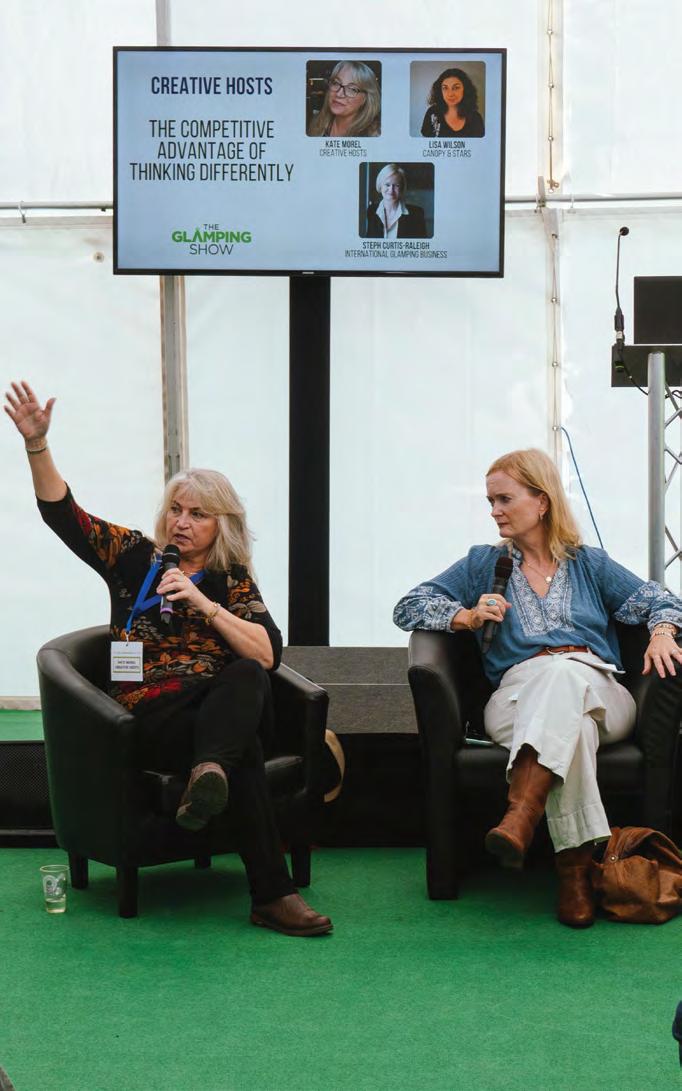
Google Ads and SEO to automation tools and integrated platforms, giving the audience a roadmap for working smarter.
The key takeaway: digital tools don’t just streamline operations , they enhance professionalism and guest trust.
Funding the Future: From Start-Up to Scale
The entrepreneurial spirit of glamping was on full display as Eamon Heggarty, founder of Coorie Retreats, shared his candid story of growing a glamping brand in a challenging economic climate. His talk, “From Start-Up to Scale: Funding Lessons for the Glamping Industry,” was a hit with attendees seeking practical financial advice.
Eamon’s transparency about both successes and setbacks made his insights invaluable. He spoke about the reality of bootstrapping a business, the difficulty of securing traditional finance, and the importance of calculated risk-taking. For many, his advice on how to prepare for expansion and avoid overextending - was among the most useful and relatable moments of the show.
Lessons from Real Hosts and The Power of Experience
One of the most talked-about sessions came from Sarah Orchard (Get Fully Booked), who hosted the engaging panel “If Only I Had Known That!” Joined by Vicki Pettigrew (Big Skies Glamping) and Jo Lewis (Enchanted Glamping at Alexander House), Sarah led a refreshingly honest discussion on the real-life highs, lows, and lightbulb moments of running a glamping business.
Delegates appreciated the candour of the panellists, who shared both triumphs and

mistakes from design decisions to marketing pitfalls. Their advice resonated with newcomers and veterans alike: stay flexible, keep learning, and remember that every misstep can lead to a breakthrough.
The sense of community in the room captured the spirit of The Glamping Show itself — supportive, collaborative, and generous with knowledge.
Planning, Practicalities and Policy Planning remains one of the industry’s most complex challenges, and Barry Davies of Davies & Co Chartered Surveyors once again drew a large audience for his Planning Masterclass. Offering straightforward advice on permissions, funding, and compliance, Barry’s message was both practical and reassuring: good preparation and professional guidance are the keys to avoiding costly setbacks.
His seminar dovetailed perfectly with John Greenshields of the Country Land and Business Association (CLA), whose talk “Don’t Overlook These Glamping Essentials” reminded attendees that even the most glamorous site rests on a foundation of health and safety, insurance, access, and business rates.
Delegates praised these sessions for cutting through complexity and offering real-world steps to safeguard profitability and peace of mind.
Creativity as a Competitive Advantage
The Friday afternoon session, “Creative Hosts: The Competitive Advantage of Thinking Differently,” led by Kate Morel (Creative Hosts) with Lisa Wilson (Canopy & Stars) and Steph Curtis-Raleigh (International Glamping Business), captured one of the most important

discussions of the event, namely how to stand out in an increasingly competitive market.
The panel examined what truly differentiates memorable glamping experiences, from design and storytelling to partnerships and guest journey mapping. Delegates came away inspired to think more holistically about their brand — not just as accommodation providers, but as curators of experience and emotion.
Understanding Guests and Using Data Smarter
Several speakers echoed the growing importance of knowing your guest inside and out, a theme captured perfectly by Beth Robinson (The Welsh Farm) in her engaging talk, “The One Thing Most Hosts Don’t Do (That Changes Everything).”
Beth encouraged operators to go beyond surface-level demographics to uncover motivations, moods, and memories — designing experiences that speak directly to those deeper desires. When combined with analytics and data tools, that insight becomes a powerful engine for loyalty and repeat business.
This was complemented by Siana Vesselinova (PriceLabs), whose session on “Smart Minimum Stay Rules” demonstrated how intelligent data use can improve occupancy rates and yield management, proving that even small operational changes can have a big financial impact.
Sustainability, Policy and the Power of Partnerships
Saturday’s programme shifted focus to the future direction of the industry, beginning with John White (GITA UK), who explored the

political and regulatory landscape for glamping. His session sparked lively debate, highlighting the need for unified representation as the sector matures.
From there, Michelle Marriott (Haigh Group) led an eye-opening session on “Smart Wastewater Solutions for Glamping Sites,” tackling one of the industry’s least glamorous but most crucial challenges. Her insights into sustainable wastewater systems and off-grid innovation demonstrated that environmental responsibility and business efficiency go hand in hand.
Finally, the closing session, “The Connected Glampsite,” brought together Alicia Whymark (Portable Power Technology), Ben Griffiths (Camping Connect), and Werner Roest (EasySecure International) for a forward-looking discussion on technology integration. Covering WiFi, security, and power management, the panel illustrated how tech can elevate both sustainability and guest satisfaction when deployed with purpose.
A Confident, Connected Future
Across every session, one message came through loud and clear: the UK glamping industry has entered a new phase of maturity. It’s data-driven, tech-savvy, financially aware, and creatively ambitious. Operators are no longer asking if glamping can be profitable — they’re asking how to refine it for sustainable success.
Speakers encouraged delegates to embrace innovation, community, and collaboration, reminding everyone that the most successful sites are those that stay personal, purposeful, and adaptable.

ADVENTURE WITH PURPOSE Visama’s Vision for Eco-Luxury in Thailand
International Glamping Business’ Editor spoke with Willem Niemeijer, CEO and Co-Founder of VHG Hospitality Asia, about Visama Tented Camps’ growth in Southeast Asia, the inspiration behind their eco-luxury concept and how tourism can be a powerful force for good in remote communities.
How did Visama Tented Camps first come about, and what inspired you to enter the luxury glamping space in Southeast Asia?
In 1993, I founded Khiri Travel, a destination management company, in Thailand. The focus was – and still is – on delivering authentic local experiences and pioneering new areas. As Khiri expanded to multiple countries, our passion for discovery led me to work with local communities that I thought deserved exposure to responsible tourists. So in 1999, we opened a small nature lodge overlooking the spectacular Tad Fane waterfalls in southern Laos. This was followed by a community-run tented camp at Bhanteay Chhmar in western Cambodia near Khmer temples. In 2015, we opened 19 units at Anurak Community Lodge on the edge of Khao Sok National Park in southern Thailand.
Our development pace quickened. In 2017, we partnered with MINOR Group and Wildlife Alliance to open Cardamom Tented Camp in Cambodia. The USP here was that a percentage of income helped to protect the surrounding 18,000 hectares of indigenous forest against loggers and poachers. The camp has since won a number of responsible tourism awards.
With proof of concept and growing experience, we created the Visama Tented Camps brand and opened Visama Mae Chan in northern Thailand in 2023 using imported safari-style tents from South Africa. Whilst our brand name is no longer on that project, it was a successful proof of concept. We moved on to create Visama Explorer Nan, also in northern Thailand. The project, with eight tents, opens 1 December 2025 and we have plans for another Visama Tented Camp in Cambodia next year.
We are on a constant lookout for additional opportunities in remote and beautiful but underserved locations. Uniting it all is our belief in tourism as a force for good. The fact that tents have a small construction footprint, are quick to develop, and allow guests a full sensory experience in natural locations while
Willem Niemeijer, VHG Hospitality Asia

staying in comfort are all key driving factors. I am very optimistic about the future of outdoor lodging across Southeast Asia.
What was the biggest challenge in turning your vision into reality?
VHG Asia has quite a bit of experience building in very remote places and we see this as one of our strengths. Finding the right location is also not too difficult for us, as we have a finger on the pulse of travellers’ demands through Khiri Travel. Furthermore, with over three decades of navigating regulations in eight Asian destinations, red tape does not pose too much of a challenge. It’s been more of an issue availing finance and getting investor confidence in a conservative sector that has its own financial modelling – often in much larger-scale bricks and mortar projects.

How did you choose your site in northern Thailand, and what makes it unique compared with other luxury eco-resorts in the region?
While Chiang Mai and Chiang Rai province in northern Thailand enjoy the vast majority of foreign travellers, Nan, towards the Lao border, is largely terra incognita for this market, with Thai tourists accounting for well over 90% of the province’s visitors. They are attracted by its stunning scenery, intact culture and lower yearround temperatures – down to 10°C in the winter. Aside from some local initiatives in the charming provincial capital Nan, there is little high-quality accommodation in the remote regions of the province.
Sustainability is often a core part of glamping. What measures have you taken to minimise impact and support the local environment and communities?
VHG Asia developed and manages Cardamom Tented Camp in Cambodia – in partnership with Wildlife Alliance and the Minor Group. This award-winning camp is a member of The Long Run, an organisation supporting a global community of purposedriven tourism businesses to accelerate positive impact across a framework consisting
of the 4Cs: Conservation, Community, Culture and Commerce.
Implementing this framework, and best practices shared amongst its members, builds sustainability, in a practical way, from the ground up. Key factors have been central to our development from the start: recruiting and training the majority of our staff from the local community, implementing energy-saving measures in the construction phase, and involving the local culture in the guest experience.
Every project has teething issues — what pitfalls or unexpected hurdles did you encounter in your first year of operation, and how did you overcome them?
In very remote areas it takes time and effort to gain the confidence of the local community to side with the project’s goals of sustainable development. Construction in such a remote, mountainous area has its challenges: landslides cut off roads, electricity is not stable, and the locally recruited construction crew needs more supervision and guidance. These types of projects are not for the faint-hearted. Then comes convincing travellers to come. The adage “build it and they will come” is still true. But it takes effort, patience and perseverance.

Visama Explorer Nan

On the flip side, what has been your biggest success story so far?
We have proven the “build it and they will come” adage with Tad Fane Resort, which opened in 1999. While we don’t claim to have opened southern Laos for foreign visitors, the small lodge did put the amazing local waterfalls on the map. The area is now one of the key destinations in southern Laos.
In terms of real conservation, not much comes close to what Cardamom Tented Camp in Cambodia achieves in partnership with the Minor Group and Wildlife Alliance. Income from the tented camp’s operation helps fund patrols by 16 or so forest rangers. (The camp’s slogan is, “Your Stay Keeps the Forest Standing”.)
Passion and perseverance are key elements in the outdoor lodging journey. Positive guest comments and ratings are a good barometer of success.
What type of guest is drawn to Visama?
Are you finding more international travellers, domestic Thai guests, or a mix?
While we develop Visama with international standards of comfort, safety and sustainability, at Visama Explorer Nan, we aim at both domestic and international travellers. It will take effort to put Nan province on the map of the discerning international traveller. We believe the specialised travel trade sector, which can inform its guests about nuances, rather than OTAs, will be the key to sustainable success – as they are with our other lodging projects.
How important has cultural storytelling been in shaping your guest experience, and how do you integrate Thai heritage and traditions into your offering?
Culture is one of The Long Run’s 4Cs – an equally important element in our sustainability framework to success. Nan province, and in particular the remote district of Bokleua where Visama Explorer Nan is located, has local culture in abundance. From ancient salt-winning wells, local tribal culture, to Nan province’s own regional take on northern Thai Lanna heritage – there are plenty of stories to tell and things to see and do.
The camp will have a traveller’s meeting place, the Ambalama. It’s a campfire inspired by Sri Lankan traditions where guests meet to exchange stories.
Looking ahead, what is your long-term goal for Visama Tented Camps?
After we open in Nan, we will start constructing in another stunning location, deep in the heart of Cambodia. We have plans for quite a few more developments in deserving, remote locations in Asia and beyond. Our team is always looking at ways to involve the local community and let guests experience indigenous culture.
Finally, what advice would you give to other glamping operators — especially those looking to create a premium, culturally rooted experience in an international market?
Join relevant associations and learn from best practice. Stay curious. It feeds motivation. The affluent market is siding with authentic, original, sustainable experiences. Be patient and keep spreading the word. Keep following your passion!
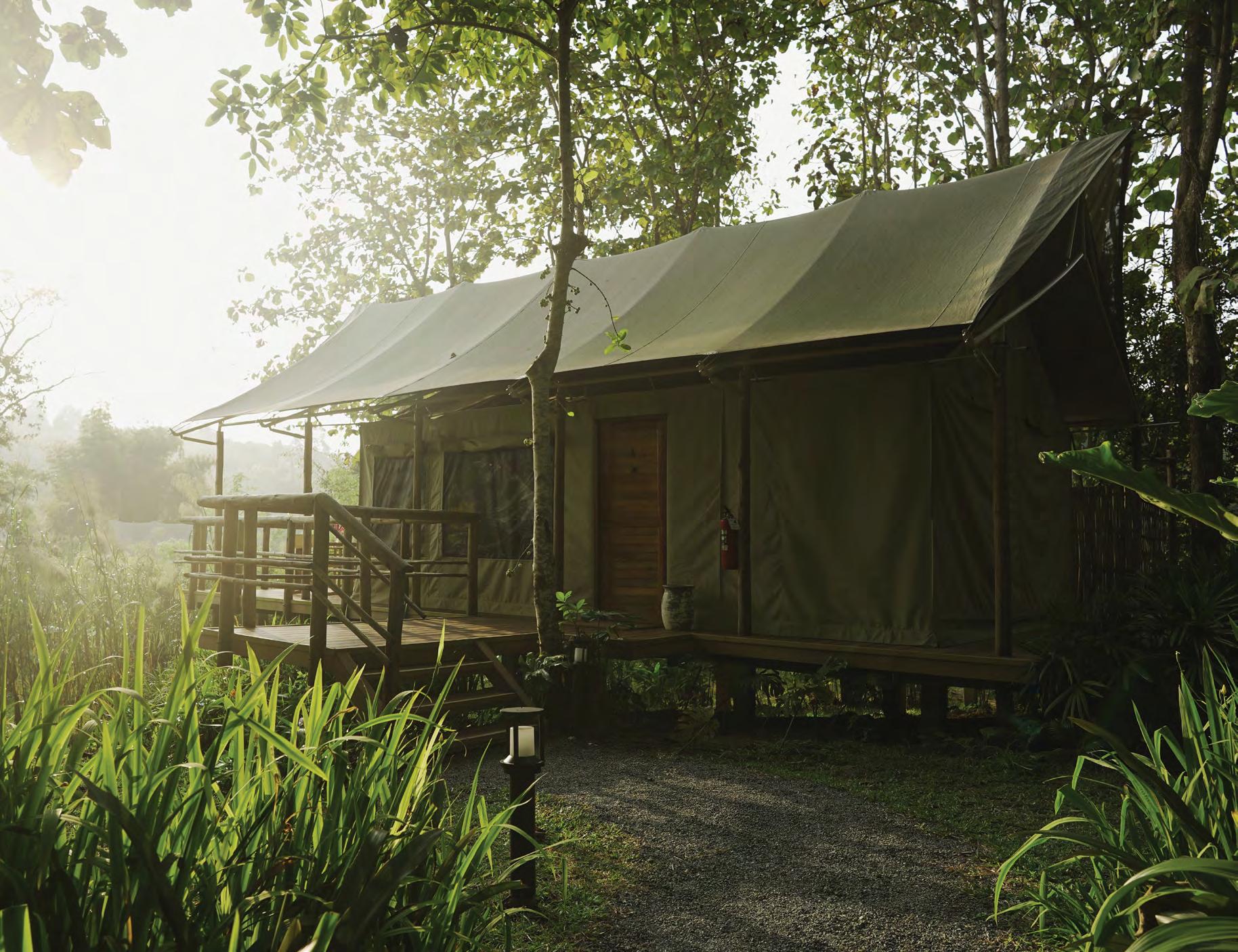
Cardamom Tented Camp rangers
Visama Explorer Nan


MAXIMISING BOOKINGS
How to Stay Ahead in 2026 and Beyond
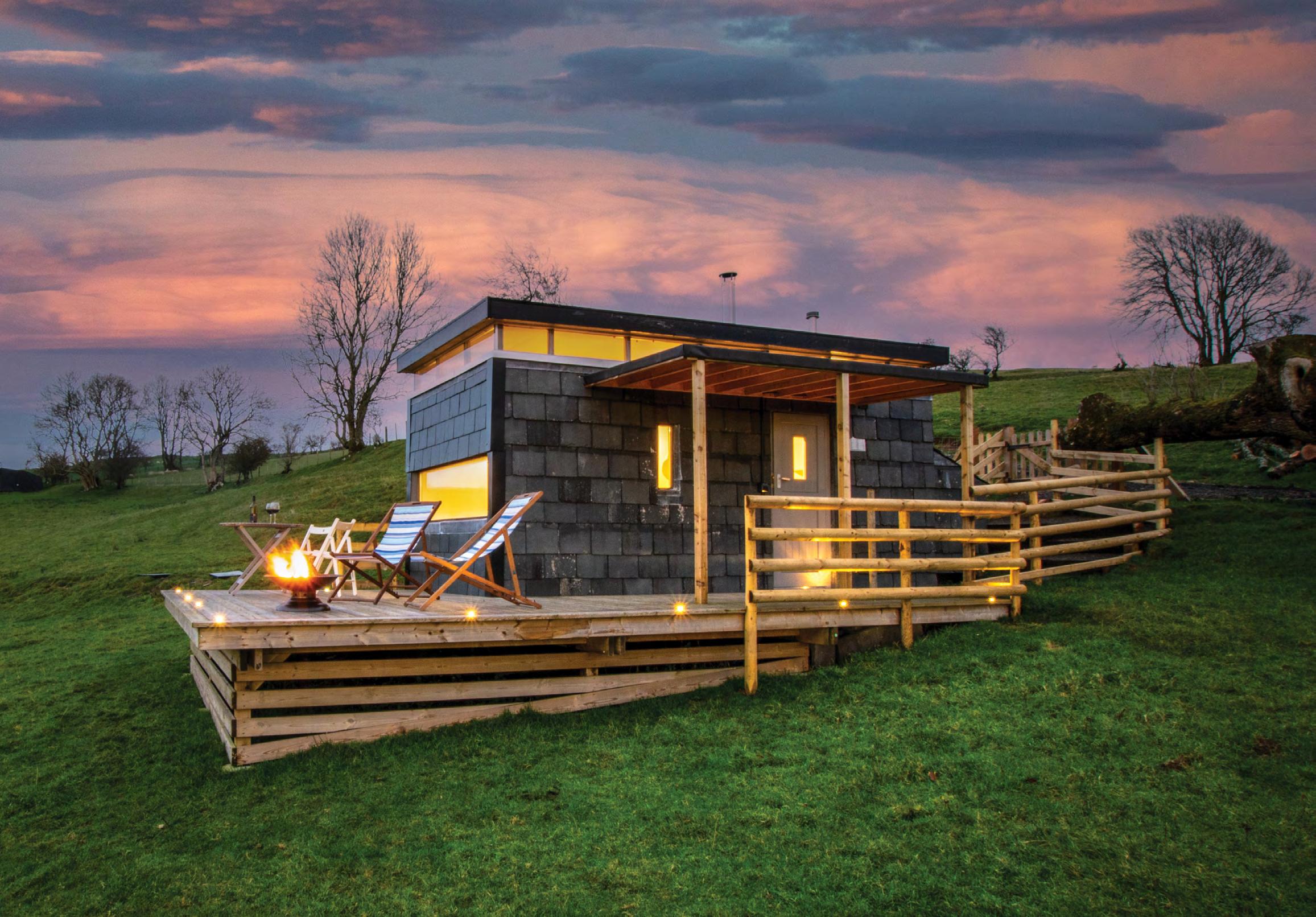
In this conversation, Joby Mussell, CCO at Travel Chapter, shares insights into the trends shaping glamping in 2026 and beyond. From maximising bookings and maintaining profitability to creating experiences that stand out, his data-driven approach and market expertise reveals what it takes to thrive in the next chapter of premium outdoor hospitality.
At The Glamping Show 2025, you presented strong figures on glamping’s growth, with the UK market projected to double by 2030. What’s driving this demand most strongly right now?
One of the main drivers is people choosing domestic travel over international holidays; glamping offers a “holiday feel” without the long-haul flight and the associated costs of travelling abroad. Then there’s the desire to experience nature and the great outdoors, but with the comfort of beds, private bathrooms, and features such as Wi-Fi. Glamping provides both, with a level of luxury and quality that makes it an attractive holiday option. No longer does it mean a tent in a field: there’s increasing investment in cabins, pods, treehouses, and yurts with private bathrooms, design-led interiors, hot tubs, and high-quality amenities.
Since the pandemic, people are increasingly looking for time out from everyday life to focus on their mental health and wellbeing. A glamping stay fulfils this need more effectively than a traditional holiday.
The strength of the UK glamping market is also fuelled by growing consumer interest in sustainable tourism, which glamping satisfies by offering a “greener” travel experience. And younger travellers are driving demand, as they seek novel, “Instagrammable” stays in unique accommodation.
Finally, changing working habits – more remote and hybrid working – have increased interest in weekend getaways and short breaks closer to home, which glamping operators are ideally positioned to offer.
Travel Chapter’s data shows average unit revenues of £15,000–£25,000 a year. What factors separate the top performers from those at the lower end of that range?
Location plays a key part. Waterside properties tend to perform well, and while you can’t control how close to the coast your site is, you may be able to consider proximity to rivers and streams, or lakes and ponds on your land, that

will help sell the outlook of the property and the feeling of escapism.
Short breaks are a major driver of booking performance – approximately 60% of bookings for glamping are short breaks. Welcoming dogs also helps a property appeal to a broader audience.
Features such as hot tubs and wood burners can increase bookings by 55% and 5% respectively. And never underestimate the importance of high-quality finishes and furnishings: the better the finish, the stronger the appeal and the more guests are subsequently willing to pay for it.
Joby Mussell, Travel Chapter

You highlighted the rise of short breaks. How should operators adjust their pricing and operations to maximise this trend?
They should think about setting themselves up for Friday/Monday/Wednesday changeovers and being able to take three-night bookings over weekends and either three or four nights during the week. This flexible approach to changeover days accommodates the busy lives people now lead and responds to demand for last-minute, more spontaneous getaways.
In addition, owners should give careful thought to their pricing strategy to take advantage of the short-break market. This is something a good holiday let agency will be advising on, but adopting flexible pricing based on availability, combined with market data that is studied by a team of analysts, will help secure those additional short-break bookings.
How do you see statutory registration and new planning classes affecting glamping specifically?
Glamping operators should not be disproportionately impacted by the introduction of statutory registration (or any new planning use classes), as most sites already meet planning, safety, and licensing requirements. The new registration scheme is expected to be largely administrative, focused initially on data capture rather than imposing additional operational burdens.
Maintaining accurate compliance records and ensuring correct business classification should help owners access existing tax efficiencies, such as Small Business Rate Relief, without significant extra cost. By leveraging these measures, glamping businesses can remain competitive and profitable while meeting any new obligations with minimal disruption.
What advice do you have for owners trying to maintain profitability under economic pressures?
Consider the audience and the offering: there is a demonstrable demand for luxury. Look at price points for comparable experiences and examine how much it will cost you to provide something similar. It’s not always a race to the bottom to reduce costs; people will still invest in luxury, premium experiences.
Where appropriate, owners should also consider tax planning and review their eligibility for things like business grants.

Seek professional advice on correct business structuring and classification with a view to ensuring compliance and leveraging all available reliefs and allowances, while always optimising profitability.
What are the biggest misconceptions new glamping entrepreneurs have?
Planning considerations are at the forefront of people’s minds. But perhaps the biggest misconception relates to the profitability of such an endeavour and whether it is worth the investment — to which the answer is a resounding yes! The UK glamping sector combines strong consumer demand, appealing profit margins, and scalable business models, while presenting an opportunity to offer a truly sustainable business. It’s an attractive opportunity for small investors and landowners looking to diversify and generate high returns.
What is the best approach to maximising the visibility of glamping sites?
There are several ways that you can maximise the visibility of your glamping site. For instance, having a visually engaging website that makes it easy for guests to search and book, investing in paid search engine ads, optimising organic performance across all searchable platforms, and developing a strong social media presence will all help deliver bookings.
Above all, we recommend using a good letting agency – like glampingstays.co.uk, part of Travel Chapter. We offer a blend of powerful digital and offline marketing, strategic partnerships with major online travel agencies, and data-driven pricing insights, all guided by your dedicated homeowner account manager. We’re also the home of over 30 other brands
that extend our marketing reach, including our leading brand holidaycottages.co.uk and our farm brand farmholidays.co.uk.
How important are unique experiences and lifestyle activities in today’s glamping market, compared with simply offering a nice unit?
Unique experiences and lifestyle activities play an important role as people look for something different from their holiday. Some accommodation is all about the location, while in other cases it’s the property itself that is the talking point. But it’s always wise to consider alternative ways to appeal to guests, and that could include activities such as meeting the neighbouring animals or features such as an outdoor kitchen.
Whatever your situation, the general rules of marketing still apply – consider the audience you want to attract and what they are looking for. Develop your product to satisfy that demand, looking for points of differentiation that help you stand out.
Looking ahead to 2026 and beyond, what emerging guest trends should operators be preparing for now?
People are increasingly choosing a glamping break because they want something they can’t get from another kind of holiday. Glamping offers guests the chance to escape into nature, to engage in a digital detox, and to focus on their personal wellbeing. We feel this will continue apace into 2026 and beyond.
º
And don’t underestimate the desire for luxury alongside the need to get away from it all –think of inviting features such as hot tubs, saunas, and quality outdoor seating.
ADVENTURE MEETS NOMADIC LUXURY Interview with Patagonia Glamping Co.
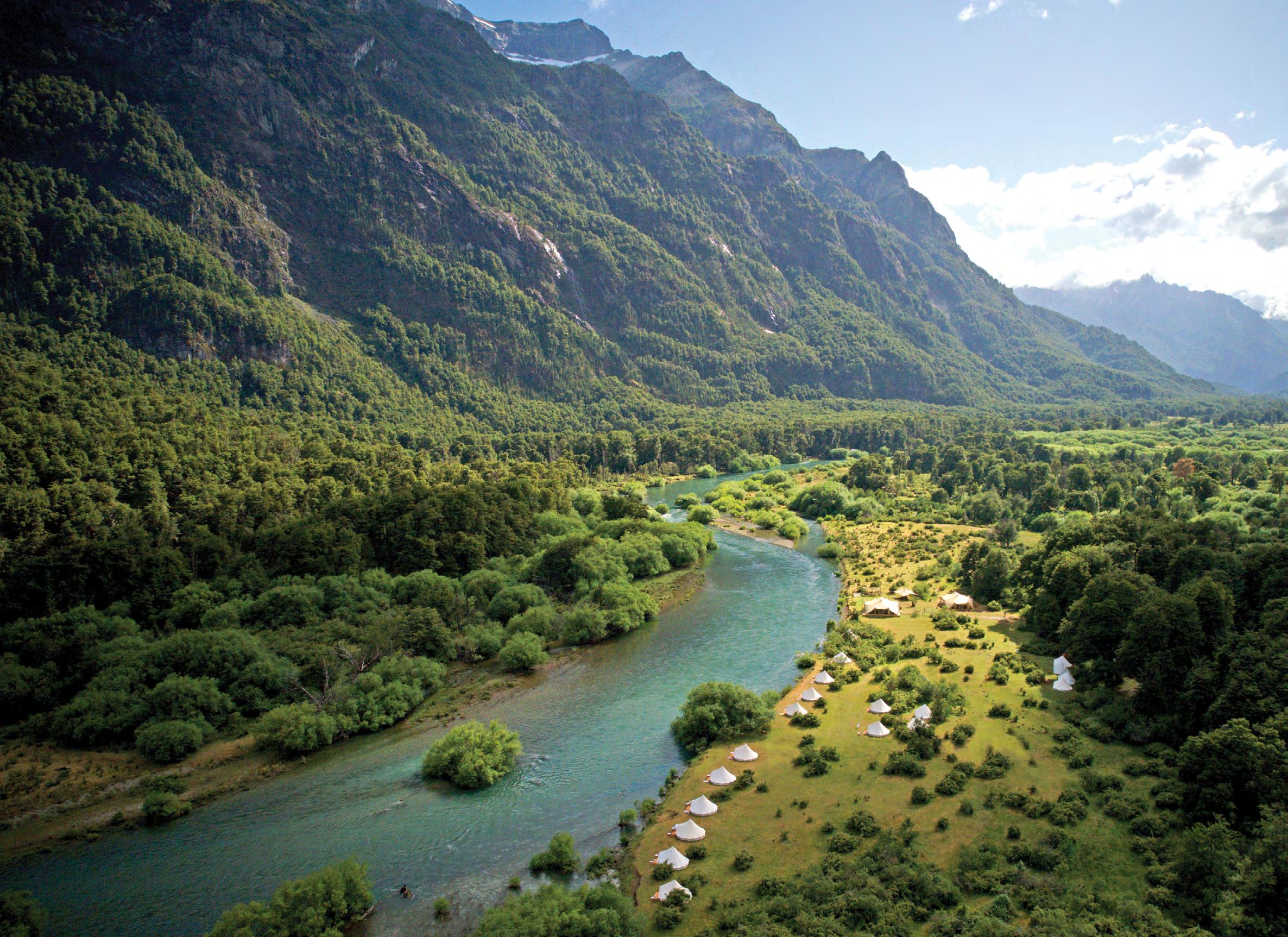
International Glamping Business spoke with Luciana Frasson, Founder and Director of Patagonia Glamping Co., about the rise of nomadic luxury camps across Argentina and Chile, how the company balances adventure with five-star hospitality, and why Patagonia is poised to become one of the world’s leading destinations for experiential, low-impact travel.
Can you tell us the story of Patagonia Glamping Co. — how did the idea for luxury pop-up camps across Patagonia first come about?
Patagonia Glamping Co. was born in 2017, following the creation of our very first nomadic luxury camp. As adventure tourism operators and mountain guides, we already had deep experience in the outdoor world, complemented by a background in design and architecture.
Around mid-2017, we received an unusual request: to design a one-night luxury pop-up camp for a couple of international travellers seeking something truly sophisticated, unconventional, and one-of-a-kind. It wasn’t
simply about setting up a dome — it was about creating a fully immersive luxury camp in a remote, hard-to-reach location with a complex set-up and teardown process.
The camp featured a custom-built structure on the banks of a river, a private deck, an ensuite bathroom with hot water, and a private chef on-site — all complemented by curated outdoor activities such as rafting, hiking, and scenic helicopter access to explore the surrounding wilderness from the air. That first experience became the foundation of what Patagonia Glamping Co. is today.
You also run Río Manso Camp in the Patagonian Lake District. How did that project begin, and how does it differ from your pop-up model?
Río Manso Camp emerged after several years of designing and producing nomadic luxury camps in different parts of Argentina, from single-day experiences to multi-night expeditions lasting up to six days.
Because these pop-up events were highly sophisticated and logistically demanding, they often came with a significant cost. We wanted

to create something that could offer the same level of service and comfort, but in a more accessible and sustainable way — without losing the essence of what makes a Patagonia Glamping experience unique.
That’s how Río Manso Camp was born, post-pandemic in 2021. We found the perfect location and started shaping it into a seasonal camp that blends comfort, design, and wilderness. Each year, the camp has grown in infrastructure and service, operating seasonally from 1 November through to the end of March. This upcoming season will mark our fifth — a milestone we’re proud of.
Luciano Frasson, Patagonia Glamping Co.
In addition, through our partnership with Frasson Luxury Travel & Events, we’ve been able to complement our on-site operations with bespoke travel design and event production services. Frasson allows us to extend the Patagonia Glamping Co. philosophy beyond the campsite — curating complete luxury journeys and destination experiences that combine adventure, design, gastronomy, and hospitality across Argentina, Chile, and beyond.
Patagonia is already worldrenowned for its landscapes. How do you balance showcasing that raw natural beauty with delivering a curated luxury experience?
Our approach always begins with the location. We seek out sites that combine awe-inspiring landscapes with remoteness and authenticity — places that invite a sense of discovery. Each destination allows us to integrate outdoor activities such as hiking, kayaking, rafting, horseback riding, or fly fishing, depending on the surroundings.
We then layer these natural experiences with a level of hospitality that meets — and often exceeds — five-star lodge standards. From personalised service and curated dining to refined design and comfort, our goal is to create a seamless balance between wilderness and luxury — an experience that feels both raw and refined, adventurous yet deeply comfortable.

How do you design, build, and operate these temporary sites — and what’s the biggest challenge in making them feel both “off-thegrid” and five-star?
Over the years, we’ve developed a detailed framework for designing and operating our pop-up projects and events. It all begins with location scouting — understanding the landscape, accessibility, and group size — and then curating the activities and experiences best suited to the area.
The ideal site should feel completely removed from civilisation. We look for places where there are no visible buildings, no neighbours,

and ideally, multiple ways for guests to arrive — whether on foot, by mountain bike, boat, or helicopter.
Every experience includes a destinationinspired gourmet programme. For example, in Patagonia, our menus often feature local trout, wild mushrooms, berries, and of course the region’s iconic Patagonian lamb, all prepared by our on-site chefs. The service is delivered by a highly trained team specialising in hospitality and luxury field operations, ensuring that even in the most remote setting, guests enjoy a seamless five-star experience.
Who are your typical clients — are they mainly private travellers, corporate groups, or global brands seeking destination experiences?
Over the years, we’ve hosted a wide range of events and clients, from corporate groups and incentive travel programmes to private families, couples, and destination weddings. We also work with adventure-based experiences like motorcycle and rally expeditions, where we provide the infrastructure and comfort of a “nomadic hotel” in remote sections of their routes — often in places where no accommodation exists or where organisers want to create something truly special.
What logistical and regulatory hurdles do you face working in such remote environments in Argentina and Chile?
We generally don’t operate within national parks, as obtaining short-term or event-based permits can be extremely bureaucratic and time-consuming — often taking between three to six months. For our model, which often requires quick confirmations and precise logistics, that kind of delay isn’t feasible.


Instead, we focus on private lands and partnerships that allow greater flexibility while maintaining full environmental respect and compliance.
You describe your work as a model of “low-impact tourism.” What steps do you take to ensure your operations leave as little trace as possible?
Our philosophy is built around low-impact, leave-no-trace operations. We design every project so that once we leave, there’s no physical footprint, no permanent structures or residual impact on the landscape.
We also make a conscious effort to leave sites better than we found them. This often includes cleaning or restoring areas, and wherever possible, hiring local staff and sourcing from local suppliers to ensure our presence has a positive social and economic effect on the surrounding community.
What has been your proudest moment or most successful project to date?
One of our proudest moments was in 2019, when we organised a one-day luxury pop-up camp for a VIP family group of 24 people to view the total solar eclipse in San Juan Province, in northwest Argentina.
The challenge was immense: the clients wanted to travel together from the vineyards of Mendoza directly to the viewing point without spending hours on the road. The only viable solution was by helicopter.
We spent nearly a year planning every detail, from scouting and building the site to coordinating eight helicopters arriving from different parts of Argentina. The result was an unforgettable, once-in-alifetime event that perfectly embodied what Patagonia Glamping Co. stands for: precision logistics, refined design, and extraordinary moments in nature.
What pitfalls or setbacks have taught you the most valuable lessons?
The greatest challenge — and our biggest teacher — has always been logistics. Every site presents unique terrain, weather conditions, and access difficulties. Over time, we’ve learned the importance of detailed planning, adaptable design, and having a strong operational team capable of executing complex setups within tight timelines.
Meticulous preparation is what allows creativity and hospitality to truly shine in the field.

How can Patagonia become a global hub for experiential luxury travel, similar to how Africa is synonymous with safaris?
Patagonia is already a world-renowned destination — both on the Argentine and Chilean sides — for its raw beauty and untamed landscapes. Yet, its potential for experiential luxury travel is still emerging.
Today’s travellers seek authenticity and transformation: experiences that feel exclusive, personal, and connected to nature. Patagonia’s vastness, dramatic scenery, and sense of isolation make it ideal for these kinds of elevated, meaningful journeys. With thoughtful development and sustainable practices, Patagonia could easily become to the Southern Hemisphere what the safari experience is to Africa.
What advice would you give to glamping operators who want to deliver high-end experiences in remote or protected environments?
Our advice would be to think beyond the conventional and focus on originality and authenticity. Every project should have a lowimpact philosophy at its core and deliver a level of service that exceeds every possible expectation. Luxury in nature is not just about comfort — it’s about care, attention to detail, and respect for the environment.
Finally, what is your long-term vision for Patagonia Glamping Co.?
Our vision is to continue creating and producing increasingly complex and ambitious events, whether in scale, location, duration, or logistical sophistication.
We’re also committed to developing new structures and specialised equipment designed specifically for luxury field operations, pushing the boundaries of what’s possible in high-end, nomadic hospitality. Ultimately, our goal is to keep redefining how travellers experience the wild, blending elegance, adventure, and sustainability in the heart of Patagonia and beyond.

WASTEWATER SOLUTIONS The Hidden Challenge

At this year’s Glamping Show, Haigh Environmental shared valuable insights on how smart wastewater solutions are helping site owners overcome planning hurdles, meet nutrient neutrality requirements and boost their sustainability credentials. In this article, Michelle Marriott, Business Development Lead at Haigh Environmental, discusses the essentials of planning, technology and communication when it comes to managing wastewater on glamping sites.
Wastewater in Early Planning
It’s rarely about mistakes and more about not knowing what options are available or who to turn to for reliable advice. There’s a huge
amount of information online, and it can often be confusing or even contradictory. The important thing to remember is that water, power, and sewage are the three fundamental building blocks when planning any off-grid site. When it comes to sewage, it’s essential to speak to a reputable wastewater specialist — like Haigh Environmental — who can help you explore the best solutions for your location and budget. The earlier you do that, the easier the whole process becomes.
What Nutrient Neutrality Really Means
Nutrient Neutrality is about protecting our environment and watercourses for the future. Many catchments across the UK already have high levels of nitrates and phosphates, which

can cause harmful blue-green algae that affects people, pets and aquatic life.
Nutrient Neutrality ensures that new developments don’t make this problem worse. It means that the total amount of nutrients leaving a site after construction should be no higher than before.
To achieve this, developers can introduce on-site measures such as sustainable drainage systems (SuDS), wetlands, or planting schemes that absorb nutrients, or purchase nutrient credits, which fund mitigation projects elsewhere.
It’s important to know that buying credits from the Local Planning Authority (LPA) isn’t the only route. In many cases, smart wastewater treatment can achieve neutrality — or even nutrient negative results — on-site. Understanding your options early is key.
Learning from Liba Vineyard
The key lesson is: don’t assume you have to buy additional nutrient credits. There are often more cost-effective and sustainable alternatives.
At Liba Vineyard, Chris and Louise upgraded their existing septic tank with a FujiClean CRXII unit and installed another CRXII system to serve their main property and glamping pods. The result was a nutrient negative outcome — meaning their site actually improved local water quality, giving them credits to spare for future development.
Michelle Marriott, Haigh Environmental
Credit: Becky Takes Photos

WE WOULD LIKE TO THANK ALL OUR MEMBERS WHO
JOINED IN OUR FIRST YEAR
Edible Trail Ltd
Woody’s Glamping
The Secret Garden Glamping
TruDomes
The Layby Lincs
Acorn Glade
Tractors and Cream
Wildwood quarry retreat
Purchasing for Parks
Tregantle farm eco glampsite
The Firs Retreats Ltd
Ty Llewelyn Glamping & Camping
Howgills Hideaway
Woodpecker Productions
Bredon View Glamping Ltd
Hadspen Glamping
The Secret Yurts
Elsenham Hall Park
Big Skies - Cotswold Glamping
Stay Balanced
Holidaynests Dyfed Ltd
Long Valley Holidays
GTF Event Equipment Finance
Wildfall Ltd
3Trees Glamping
Glampitect
Lady Heyes Holiday Park
Devonia Escapes
Llain Meadow
Upgrade Publishing
Meadow Field Luxury Glamping
Glamping Academy
SUPA Products Ltd
Tree Tents International Ltd
Logspan
Bespoke Hideouts
Hush Hush Glamping Ltd
ÖÖD Mirror House
Mattressman Ltd
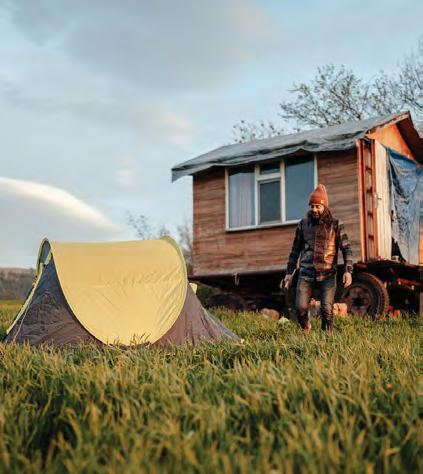
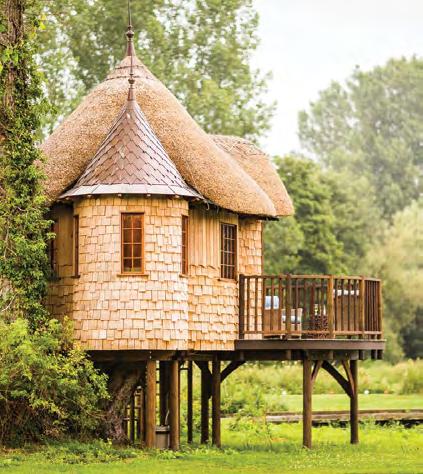
Arran Park Ltd
Plastic Solutions (Aldridge) Ltd t/a Glampsan
Unique Hideaways
Old Pound Smithy
Off Grid Travel
Swan Events Ltd
Morel Consultancy
One Acre Wood
Watercress Glamping
BoerenBed UK B.V.
Kingfisher Lakes
Deer Barn Ltd
Crystaline Communications Ltd
JAM Start Ltd
Chase Farm Glamping
R Design Treehouses
Tower Farm Holidays
Toucan Art Ltd (Moorlands B&B)
Coal Bunker Leisure Buildings
Pond view lodges
Field with a View Winchester
Rubus Ltd trading as Beara Lodge Glamping
ResNexus
GlampLaunch
Woodland Escapes Ltd
Jenna Corrigan Design Co Calor
Windward Retreats Ltd (t/a Wildwinds Glamping)
GMR Consultancy UK Ltd (for Meadow View Glamping)
Little Seed Field Earthstays
Heritage Garden Studios Ltd
GFM (Scot) Ltd
Snapfix
Roaches Retreat Eco Glampsite


Cirsium Ltd
The Hudnalls Hideout
Higher Hills Ltd
Pont Tyweli Glamping Ltd
Chester Charm Retreats (Medics Accommodation)
Redhill holidays
The Hide at Manton Bay
Flame Marketing Ltd
Gala Tent Ltd
Secret Garden Devon
Waites Farm Glamping/Form Of Intelligence Ltd
Coorie Retreats
Bella Vista Camping
Fronteifi Nature Lodges
Sofabedbarn Ltd
Croft Farm Water Park
Anglezarke Pod Company
Snowdon Domes
Podfactory Ltd
Sarah Carr Designs (Fensend Getaways)
Lifestyle Eco Lodges Europe Ltd
Mat Zero Heat Ltd
Barn Retreat Leisure
Logs Direct Ltd
Anytime Booking
Fotheringhay Glamping
Magna Money Holidayfox
Iron & Pine Ltd
Porth Eryri Glamping
Copper Beech Glamping
Cuildochart Forestry Ltd
Aelso Ltd
TGL Ltd



Their proactive approach not only unlocked planning approval but also future-proofed their business.
Why Early Engagement Matters
It’s key to plan for wastewater solutions as early as possible. The sooner we can assess the site and understand your plans, the better we can help identify cost-effective, compliant options. Early engagement prevents delays and avoids wasted investment in unsuitable systems.
Exploring the Options Beyond Septic Tanks
There’s a range of options, from septic tanks and cesspits to pumping systems that connect to the main sewer, and more advanced sewage treatment plants.
In sensitive areas where nitrates or phosphorus need to be mitigated, a sewage treatment plant (or in some cases a sealed cesspit) is usually the only compliant solution.
Costs vary widely depending on site layout and scope of works — typically anywhere between £2,000 and £12,000 for supply only, or up to £15,000 including full installation. Every site is unique, which is why it’s essential to get tailored advice.
In terms of upkeep, all systems require regular desludging, and some need a small power supply and annual maintenance by an accredited service provider.
Seasonal Flexibility in Modern Systems
There’s a big advantage of modern systems like the FujiClean CRXII. It combines anaerobic and aerobic treatment, meaning it can handle both very low and high flows without compromising performance.
In simple terms, this “flow equalisation” allows the system to cope with seasonal variations — from quiet winter months to busy summer weekends — while maintaining consistently clean discharge levels.
Wastewater as a Sustainability Asset
The Liba Vineyard project is a great example of this. Their choice was either to spend tens of thousands of pounds on nutrient credits from the LPA, or to invest in treatment plants that achieved nutrient neutrality — and even moved them into a phosphate-negative position.
This approach is becoming increasingly common as more planning authorities tighten environmental requirements. Beyond compliance, it also adds genuine ecocredibility to a site’s sustainability story.
Regulation
Is
Tightening
— Here’s What That Means Regulations are evolving quickly. Years ago, septic tanks were widely accepted, but that’s changing as environmental standards become stricter.
Local Planning Authorities are now far more cautious, often requiring detailed performance evidence. Some treatment plants don’t perform as well in practice as their certificates suggest, so it’s vital to choose systems with verified real-world data.
Having worked in the industry for over 20 years, I’ve seen more regulatory change in the past five years than ever before — and that trend is set to continue.
Turning Infrastructure Into a Story Guests Care About
Guests rarely see what happens behind the scenes, but sustainability-minded travellers are increasingly curious. The key is to tell the story simply and positively.
Some effective phrases include:
“We clean every drop before it returns to nature.”
“Our system saves thousands of litres of water each day.”
“Nothing leaves our site untreated, protecting local ecosystems.”
“Our onsite treatment keeps nutrients out of the nearby estuary, helping the wetlands stay healthy for the birds you’ll see on your morning walk.”
Small touches can make a big impact. In-room signage or digital guides explaining how the system supports a closed-loop water cycle, or short eco-tours or social media features showing how the site protects its surroundings.
In short, wastewater systems may be invisible, but they’re powerful proof of genuine sustainability.
By turning technical infrastructure into a story of care and circularity, operators can both educate and inspire guests.
Practical Advice for Glamping Sites
Every project is unique, but for a small site with two or three units (each housing two to four people), we’d typically recommend a 10–12 person sewage treatment plant.
A realistic budget for supply and installation would be £12,000–£15,000 + VAT. The key is to get expert guidance early — not only to meet planning requirements, but to futureproof your setup as your site grows.
Our advice is simple: involve a wastewater specialist from the start, explore your options, and plan for expansion. It’s an investment that pays off in compliance, sustainability, and peace of mind.
In Closing
Whether it’s a two-pod start-up or a luxury vineyard retreat, smart wastewater management is one of the most important — yet least visible — parts of sustainable glamping. With the right system and early planning, operators can save money, protect local ecosystems, and proudly share a sustainability story that runs deeper than guests might imagine.

Credit: Becky Takes Photos

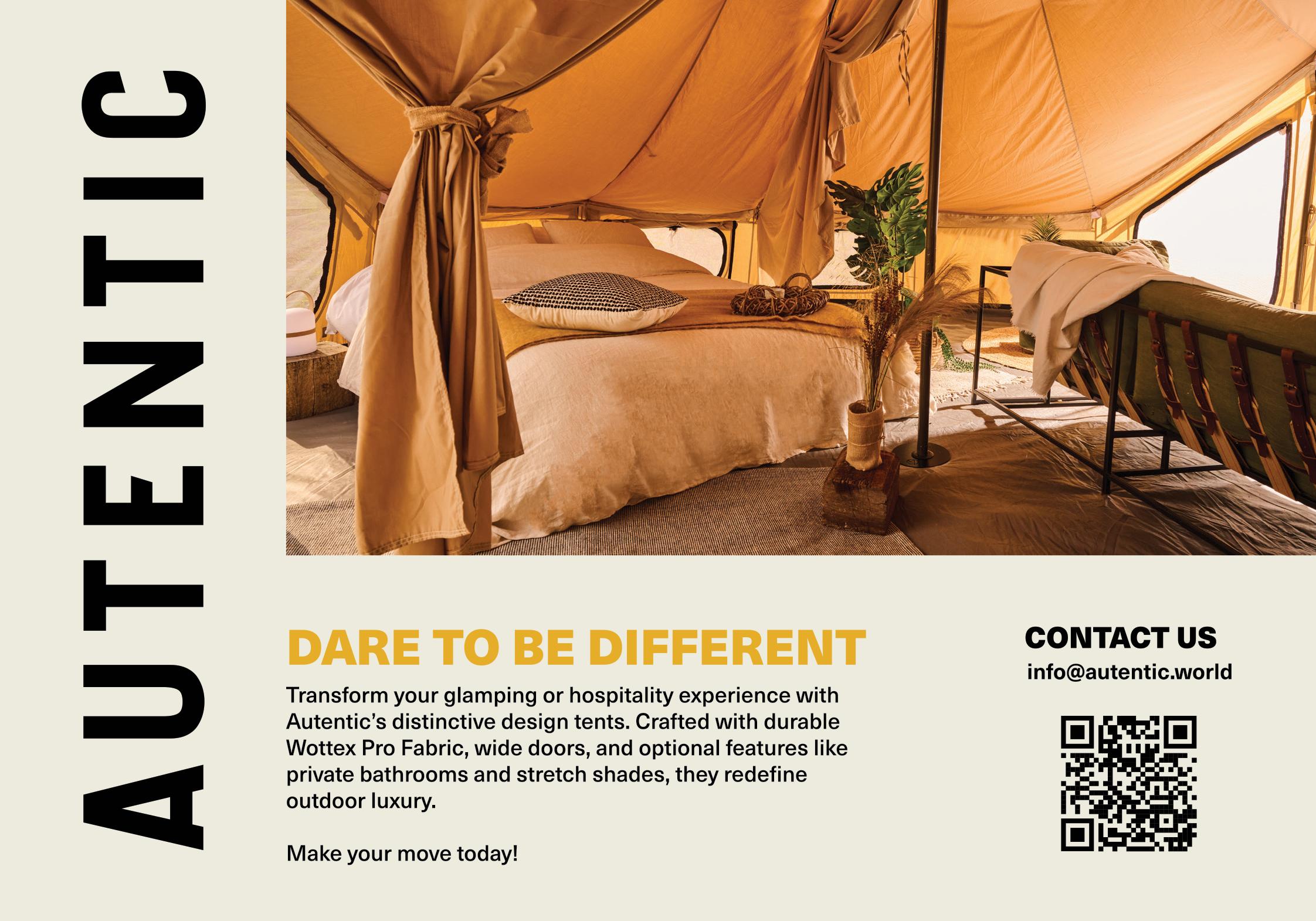
HOW PEOPLE SEE THE SKY How a Lighting Designer Transforms

Etta Dannemann, a lighting designer and architect, spent years mastering the interplay of artificial light in cities. But it was her fascination with natural darkness that shaped a new chapter — one devoted to helping others experience the transformative potential of truly dark skies. “I am fascinated by the power of dark sky experiences, and I want others to experience the same sense of perspective and tranquility,” says Etta.
Based in Berlin, Etta works with glampings, startups and hotels worldwide. Her concept emerged from a simple bottleneck: in remote regions, stargazing events are rare — yet so many guests long to make the most of the night sky. “The Visit Dark Skies® stargazing audio experience was born from my desire to share my passion for the night sky with my husband, but I couldn’t find a romantic, atmospheric way to do so — only busy tours or empty parking lots. I knew we could do better.”
While researching dark sky destinations, she noticed a consistent gap. Most offerings were group-based astronomy tours that didn’t fit couples or solo travelers seeking something more intimate — a chance to look up quietly and reconnect. She recognized a need for customizable experiences that guests could enjoy independently, at any time.
This insight sparked “Guided Stargazing,” the first in a series of immersive audio experiences. To bring it to life, Etta collaborated with renowned astrophotographer Bernd Pröschold, as well as astronomers, cultural experts and musicians. The result encourages listeners to savor the process of eye adaptation
— the subtle, profound way our vision adjusts to deeper darkness. She co-wrote the script, weaving together lighting expertise with immersive storytelling.
Months of testing with real guests and industry professionals ensured the right balance of scientific accuracy, relaxation, and gentle guidance. Etta explains, “We always test with real guests and industry professionals because our aim is consistent quality. It’s about delivering value to both the operators and the people who come to reconnect with nature.”
The response was immediate. Glamping operators loved that the experience was both accessible and deeply memorable — without requiring staff or scheduled programming. “We work now with glamping owners in many regions of the world that offer this immersive experience to their guests,” Etta notes. “Their properties need to be remote and attract an urban audience who crave a break from city lights. Our experiences help them offer something truly memorable.”
After Stargazing’s success, Etta wanted to create a daytime equivalent — something that would complement the night sky and expand what outdoor hospitality could offer. She partnered with Gavin Pretor-Pinney, founder of the UK’s Cloud Appreciation Society, to develop Guided Cloud Gazing, a 30-minute narrated audio journey that blends cloud science, storytelling, and serene soundscapes. Testing with experts and guests ensured a well-rounded product fit for glamping sites, eco-lodges and nature tourism providers.
The creation process transformed Etta personally as well. “Since crafting the audio

Etta Dannemann, Visit Dark Skies
cloud walk, my life quality has improved so much: I appreciate clouds and the topic of change in general, I am less anxious, I feel much more grounded and inspired every day.”
Her mission extends beyond leisure — it’s about helping more people notice what’s above them, and in that stillness, notice themselves. “When you lie back and really look up, you realize how much there is to gain from slowing down,” she says.
Owning her business outright, Etta sees a bright path forward. “I’m really glad we’ve struck a chord, starting with customers ranging from specialized glamping providers and startups to even corporate hospitality providers. Now is the time to launch the daytime version with a special offer. I look forward to meet passionate hosts with a strong focus on customer experience.”
Through collaboration, experimentation and a deep reverence for nature’s rhythms, Etta Dannemann is reframing skywatching as an essential part of modern outdoor hospitality and changing how people look up.
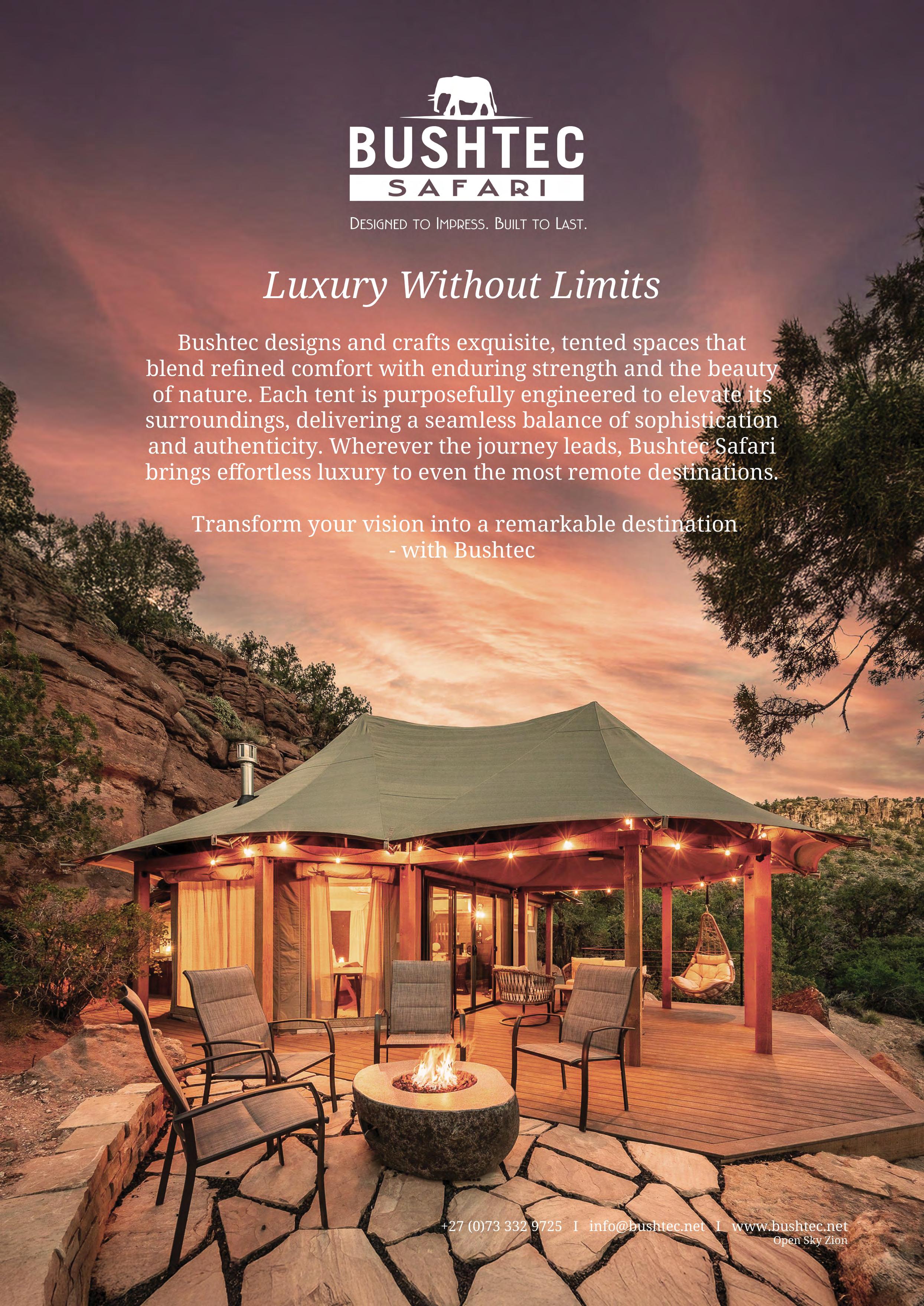
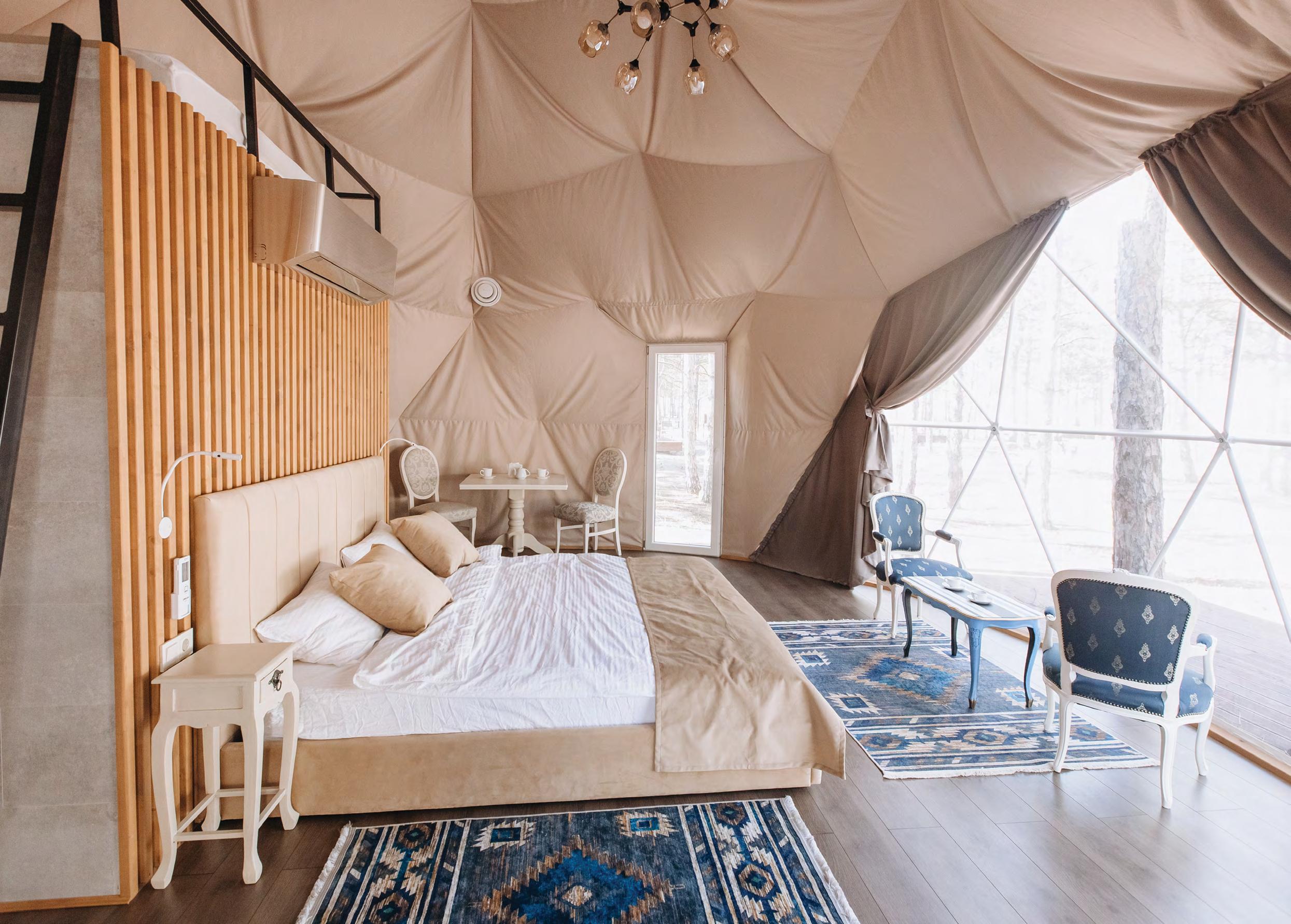
ECOPOD Innovative Glamping Solutions Transforming the Market
Today, glamping is evolving from a travel trend into a full-fledged industry. The glamping market in Europe is projected to reach US$ 2,082.5 million by 2030, with an expected compound annual growth rate of 9.5% from 2025 to 2030.
It is in this rapidly growing segment that ECOPOD offers solutions combining innovation, fast installation, and affordability.
Speed & Efficiency
One of ECOPOD’s key advantages is its full-cycle production. All elements of the structures — from steel frames and membranes to windows and platforms — are manufactured in-house. State-of-the-art technologies, automated machinery, and a professional team ensure precision, consistent quality, and the ability to adapt each dome to specific environments — from the slopes of the Alps to the shores of the Mediterranean.
All materials are EU-certified, eco-friendly, and safe, ensuring not only reliability but also long-term durability. Our geodesic domes can be installed within just 1-3 days, depending on size, allowing glamping investors and operators to launch projects in record time.
Price Advantage
By managing the entire production cycle in Ukraine — from metal frames to turnkey interiors — ECOPOD keeps costs 30-40% lower than most competitors. For example, the Private L model in its basic configuration costs up to £3,500.
Flexibility & Innovation
The product range includes various models: Private L, XL, Panorama Vision, Hexadome, Shell, and more. We offer options with panoramic windows or glass façades, insulation, integrated engineering systems, and even fully finished interiors. Every project can be tailored to customer needs — from boutique hotels to large-scale glamping resorts.
One of ECOPOD’s flagship projects is a glamping resort on the Danube near the Black Sea, featuring 43 eco-structures — among the largest glamping developments in Europe.
Another landmark achievement is one of the most technically complex domes in the world in Puerto Rico. Designed for extreme conditions of humidity, heat, and hurricane winds, ECOPOD engineers created a reinforced frame system capable of withstanding gusts of over 200 km/h. Special
anti-corrosion materials adapted to marine climates were used. Our team successfully delivered and installed a 30-meter dome with reinforced steel frame (14 tons of metal) and 1,700 m² PVC cover.
Experience & Trust
Since 2020, ECOPOD has completed over 120 projects worldwide — from Ukraine to Central and Western Europe, Latin America, the USA, and Canada. Our domes are already operating in mountain regions, coastal areas, and urban recreational spaces. Clients highlight not only the quality and design but also our service: consulting, logistics, installation, and ongoing support.
Why ECOPOD?
n Fast deployment: 1–3 days installation
n Competitive pricing: 30–40% lower than EU averages
n Full-cycle production: from frame to turnkey interiors
n Global expertise: 120+ projects delivered internationally
ECOPOD combines architectural aesthetics, practicality, and a profitable investment model — creating unique spaces that attract customers and ensure fast ROI.
IRON & PINE Shipping Containers
Are the Smart Choice for Glamping Sites

Let’s be honest: the glamping market has reached a turning point. Guests expect boutique hotel comfort in the wilderness, and your profit margins depend on minimising maintenance whilst maximising occupancy year-round.
If you’re serious about competing in today’s glamping landscape, it’s time to consider what progressive site owners already know: shipping container conversions aren’t just trendy—they’re one of the most strategic accommodation investments you can make.
The Case for Steel and Longevity
Smart glamping operators understand that initial investment needs to deliver returns for decades, not just seasons. Converted shipping containers offer exactly this kind of longevity. Built from marine-grade steel designed to survive ocean crossings, these units provide genuine durability that translates directly to lower lifetime costs and reduced downtime.
Iron & Pine’s luxury modular buildings exemplify this perfectly: the industrial strength of shipping containers transformed into premium retreats that weather British storms without compromise. This isn’t about sacrificing aesthetics for practicality. Today’s container conversions deliver high-end
finishes, sophisticated layouts, and genuine luxury interiors—your guests experience boutique hotel quality in one of the most resilient structures available.
The financial logic is compelling. Whilst maintenance budgets can erode profitability over time, structures built to last protect your margins and keep units available for booking rather than under repair.
The Speed and Flexibility Advantage
Here’s where container conversions truly distinguish themselves: deployment speed. Modular units arrive essentially complete, with Iron & Pine constructing off-site in controlled workshop conditions. Once delivered to your prepared foundations, you’re revenue-ready within days rather than months. That’s not just convenient; it’s financially transformative when every week counts during peak season preparation.
The modular nature offers another underappreciated benefit: adaptability. Need to expand? Just add some extra containers to your site. Want to test a new site area? Containers can relocate easily. This flexibility is insurance against the unknown, allowing you to respond to demand without the commitment paralysis that can hold businesses back.
Sustainability That Actually Matters
We’re past the point where “eco-friendly” is a nice-to-have. Today’s glamping guests actively seek sustainable accommodation, and they’re savvy enough to spot greenwashing. Repurposed shipping containers offer genuine environmental credentials—you’re giving industrial materials a second life whilst avoiding the carbon footprint of new-build construction.
But the real sustainability story is operational. Advances in insulation practices mean dramatically lower heating costs year-round. In an era of volatile energy prices, this isn’t just good for the planet—it’s essential for protecting your margins. Energy-efficient units allow you to maintain comfortable temperatures without anxiety over utility bills, which means you can offer year-round availability and capture revenue in shoulder seasons that others might write off.
The Bottom Line
Glamping site profitability hinges on one calculation: maximising revenue whilst minimising operational costs and downtime. Shipping container conversions like Iron & Pine’s luxury modular units, deliver on both fronts. They’re built to last, quick to deploy, cost-effective to run, and provide the elevated guest experience that commands premium rates.
The question isn’t whether container conversions make sense for every site—different locations have different needs. But for operators seeking durable, sustainable, and strategically sound accommodation that can perform year-round, the case for converted shipping containers becomes increasingly difficult to ignore.



A-FRAMES are UK’s Glamping Game-Changer

As the chill of autumn gives way to winter’s whisper, glampers seek more than a tent – they crave immersive, sustainable sanctuaries that blend nature’s embrace with modern comfort. Avrame UK’s A-frame kit homes are redefining glamping, offering luxury structures that not only provide a perfect retreat but also pay for themselves. These triangular timber wonders aren’t just structures; they’re portals to year-round luxury, where sloped roofs pierce the sky like Nordic fairy tales, inviting guests to unplug and recharge amid Britain’s wild landscapes.
Hailing from Estonia, Avrame’s kits, designed by the group’s CEO, Indrek
Kuldkepp, combine Nordic craftsmanship with modern efficiency. Pre-cut and preengineered, these timber homes assemble in as little as two weeks with minimal labour, significantly reducing build times and costs compared to traditional cabins. Cold-bridgefree designs and triple-glazed windows ensure year-round comfort, whether braving Dartmoor’s drizzle or the Highlands’ chill.
Avrame’s range caters to every glamping vision, from the compact Solo+ series (starting at 57m²) for intimate couples’ retreats to the spacious Trio series (up to 150m²) for family-friendly lodges. The innovative Double A-frame, merging Duo and Trio models, even offers 200m² wellness wings with integrated saunas – perfect for eco-luxe sites.
What makes Avrame a glamping goldmine?
Their A-frames are rental magnets. The bold rooflines, open interiors, and nature-centric designs scream Instagramworthy, driving bookings on platforms like Airbnb. Guests pay premium rates for these unique stays, and owners report covering costs with just a few monthly bookings. A Devon host on Reddit shares, “Our Avrame cabin books faster than any other listing. It has a cosy yet modern vibe.”
Owners can customise layouts with no load-bearing walls – think loft bedrooms or double-height lounges. Eco-friendly options such as solar panels and green roofs appeal to sustainability-focused glampers. Affordability is key to Avrame’s success. Avrame kits revolutionise construction costs by halving them. With transparent pricing and UK-compliant designs, planning permissions are simplified. For instance, Northumbria’s Calvert Trust praised Avrame’s “next-level quality” for their accessible Kielder Forest lodges, built on time and within budget. This means faster returns for glamping entrepreneurs. A smart layout in a prime location – whether Cornwall’s coast or a Welsh valley – transforms an Avrame into a vacation home that suits your needs. Rent it when you’re away, enjoy it when you’re there, and let guests cover your mortgage and utilities.
Eco-conscious glampers will appreciate Avrame’s green credentials. The A-frame’s compact footprint minimises land impact, while its shape supports energy-efficient features such as solar panels or off-grid setups. A Lake District owner, who paired their Duo model with a rainwater system, aptly describes it as a “cabin that respects nature.”
Ready to build your glamping empire?
Give Avrame UK a call, browse their catalogue, choose your dream spot, and create a retreat that’s uniquely yours. From minimalist pine to vibrant cladding, your A-frame can reflect your style while generating income. With the UK glamping market growing 10.9% annually, Avrame UK offers more than a cabin – it’s a savvy investment, a sustainable sanctuary, and your ticket to a winter escape that pays its own way.
TENTHOUSE STRUCTURES Made for the Wild, Built to Last
In the world’s most extraordinary landscapes, nature leads, and we follow. At Tenthouse Structures, the wild drives our purpose, shapes our design, and leads us to a sustainable future.
For more than 15 years, our expertise in textile architecture and tensile engineering has been honed in the wild, tested across continents, climates, and client visions. Our work combines the art of textile architecture with the precision of tensile engineering, disciplines that demand both creativity and calculation.
This unique blend allows Tenthouse to design unique structures that span great distances with minimal material, unifying strength, lightness, form and function.
Each project stands as proof of our ability to transform tensile structures, from iconic roof membranes to luxury villas, cabins, and safari tents, into enduring architectural works that perform with elegance and integrity. Tenthouse also delivers turnkey camp solutions, uniting design, engineering, manufacturing, logistics and installation into a seamless process that realises every detail of a client’s vision whilst executing on time and in budget.
We create more than tented structures. We engineer long-term value: spaces where design, sustainability, and performance converge to deliver meaningful returns for owners and unforgettable experiences for guests.
Every line, surface, and junction reflects our belief that the wild should define how we build. Our eco-engineered systems merge tensile architecture with advanced structural and lightweight building innovation, ensuring that what we create is as bold as it is buildable.
By integrating advanced simulation tools and material testing into our design process, we predict how every cable, frame, textile surface and building envelope component will perform under real-world conditions, from extreme winds to tropical humidity. This ensures that beauty never compromises performance and that each Tenthouse structure functions consistently, season after season.
Our structures are light on the land and long on life: low-impact, highperformance solutions that respect the environment while protecting investment. Through intelligent engineering and modular systems, Tenthouse properties achieve faster installation, lower maintenance, and exceptional durability, reducing lifecycle costs and amplifying returns over time. Our modular approach also allows for easy refurbishment and scalability, giving operators the flexibility to evolve as demand grows while preserving capital investment.
Behind every project lies our people: engineers, architects, craftsmen, project managers and site experts and united by precision, partnership, and experience, celebrating the mastery that turns vision into value and creativity into commercial advantage. Tenthouse Structures is where technical expertise meets human intuition, and where collaboration and passion shape innovation.
Tenthouse Structures represents a new era of wilderness architecture, where beauty meets performance and sustainability drives success. For over 15 years, we have proven that what is made for the wild can truly be built to last.


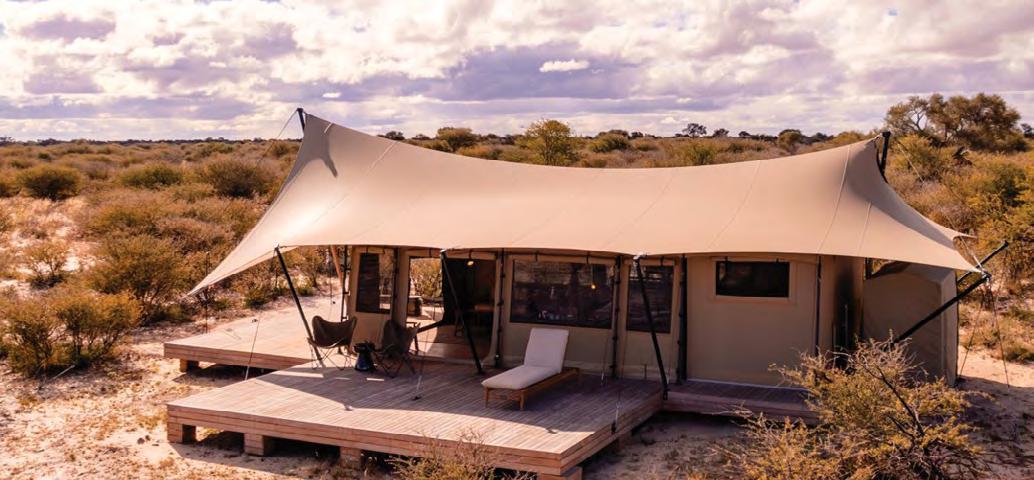


Structures can literally be created, designed and built for any situation, whether it’s for a glamping site or, alternatively, for a private client who wants to develop and grow their offerings to customers. These structures, as with all products from Woodpecker, can be built to accommodate any number of guests or to serve as a communal area for when guests are looking to socialise with family and friends as and when the need arises.
Importantly, by providing an experienced outlook on the structures to our customers, as we do with every project we undertake, understanding what the customer wants becomes a lot easier and smoother throughout each and every stage. This leads to the completed product looking more like what the customer envisions, rather than something simply ‘off the shelf’ and nothing at all like what the customer needs.
With all of these structures, there is also a need to use the best materials in their construction, whether that is Scandinavian spruce, thermo wood, larch, elder, ash or any number of other possible wood solutions available to us during production. This leads to the creation of a product that is longlasting, able to weather naturally, and remain functional for years to come, as long as the customer treats it properly and maintains its upkeep, therefore extending its lifetime.
The products that we create range from something as simple as a garden-style building with sliding doors and a wonderful interior space that can accommodate anything from a bedroom to a kitchen space for indoor and outdoor use, to something more sophisticated such as a place to relax and unwind with sofas, seating cushions, tables and a space to


The Versatility of
WOODPECKER
make drinks to enjoy with your family. At the top end, our modular house includes two sections (6m x 2.4m) featuring a bedroom area, kitchen and dining area, as well as a fully fitted bathroom with a walk-in shower, toilet and basin unit, adding that element of luxury to any glamping setting.
Additionally, there is also the option to have a number of our sauna units converted into accommodation structures, whether it’s the leaf sauna with its unique, spacious interior and the option of full panoramic glass at the rear, or alternatively a larger barrel sauna that can be adapted to include a kitchen or a bedroom and living area. This adds a different angle to the unit, offering something beyond the standard options presented here.
Why, then, would you choose to work with Woodpecker in the creation of your units?
From the research we have carried out ourselves at shows, in telephone conversations and elsewhere, the main reasons include being “cost-effective”, “value for money”, “able to get more for your money”, and “a long-term investment”. These are just some of the things that our customers and other industry stakeholders, who value working with Woodpecker, have shared — many of whom have been alongside these industry professionals from the start of their own glamping journeys.
One of the most important things to consider when choosing Woodpecker products is that the products highlighted in this article are just a few of the options available to customers. Woodpecker provides freedom of choice for all customers, regardless of budget, taste, style, or any of the other factors involved in your decision-making process.
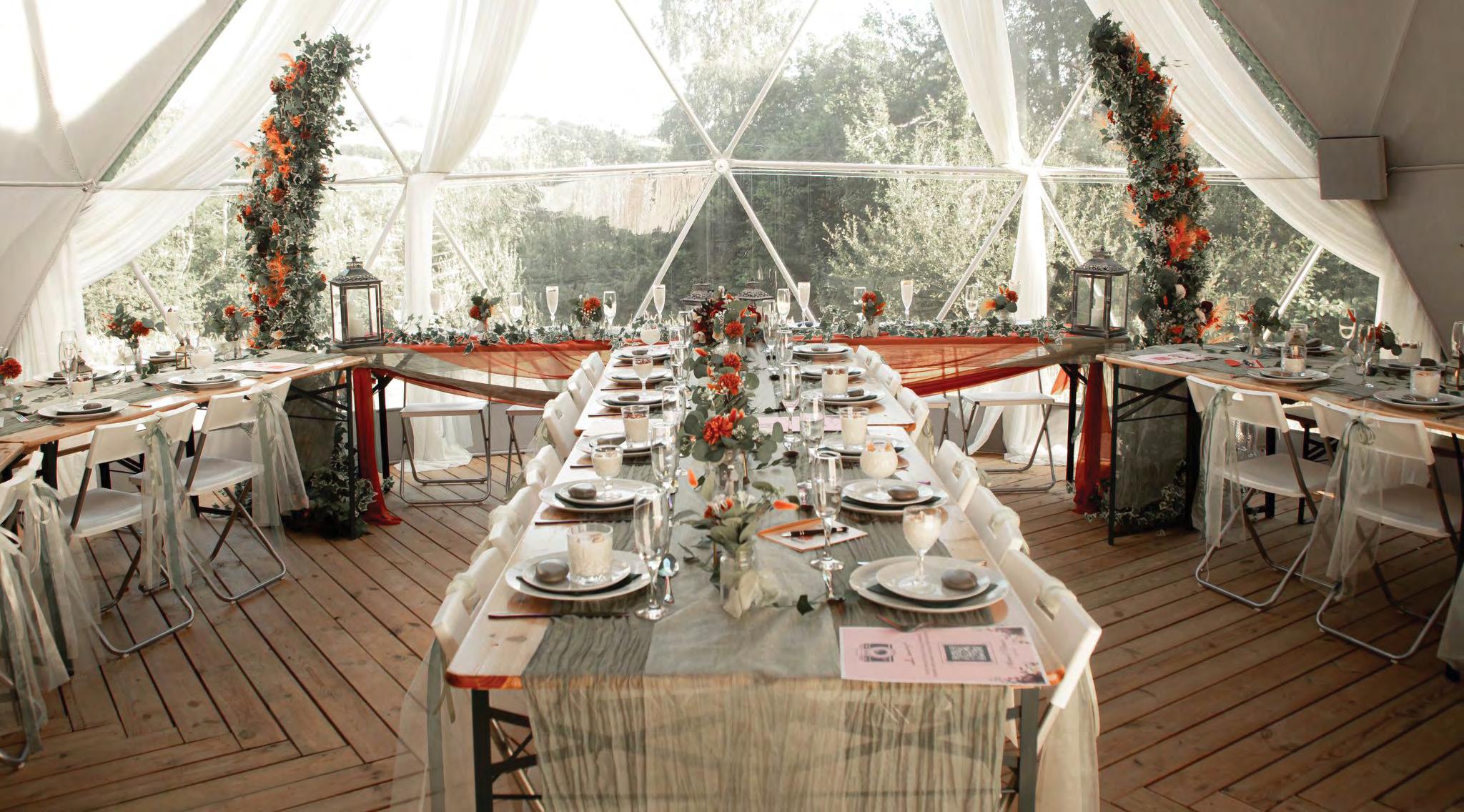
TRUDOMES A Dome Isn’t Just for Glamping
For many site owners, a glamping dome begins as a stylish accommodation option, but the potential goes far beyond that. With their open-plan design, strength, and adaptability, domes offer an opportunity to create multi-purpose spaces that can evolve with a business. From yoga retreats and workshops to weddings and private hire, a dome can be so much more than somewhere to stay.
That’s exactly what happened at Cae Nant Glamping, a picturesque site nestled in the Welsh countryside, where owners Charlie and Gareth discovered just how versatile a dome can be.
A Flexible Space for Every Occasion
When Charlie and Gareth launched their glamping site, they started with a collection of 7m domes offering peaceful stays, hot tubs, and panoramic views. But it was the addition of an 8m TruDome in late 2024 that transformed their offering.
Unlike traditional accommodation, the 8m dome provided a blank canvas — a selfsupporting aluminium frame with no internal columns, allowing the space to be styled and adapted for any purpose. Whether used for group bookings, workshops, or private celebrations, the dome quickly became the heart of the site.
“Adding the larger dome gave us so many options,” says Charlie. “It’s a beautiful, lightfilled space that works for anything, from yoga sessions and family gatherings to weddings. It’s helped us expand what we can offer without adding more guest domes.”
Turning a Glamping Site into a Destination
The versatility of the structure soon paid off. This summer, Cae Nant hosted its first wedding, with guests hiring the entire site for a weekend of celebration. The couple, who had first visited as glamping guests in 2022, fell in love with the setting and wanted to share it with friends and family.
The 8m dome became the centrepiece, transformed into a stunning venue framed by the surrounding hills. With its panoramic window and open layout, it offered the perfect backdrop for a relaxed countryside wedding, showing how adaptable the space can be.
A Strong, Sustainable Solution
For Charlie and Gareth, choosing a TruDome was about quality as much as aesthetics. The anodised aluminium frame offers durability and long life, while the PVC cover is weatherresistant and easy to maintain — essential for the unpredictable Welsh climate.
“It’s strong, simple to look after, and looks amazing in any season,” says Charlie. “We’ve used it for workshops, parties, and even quiet
retreats. It’s completely changed how we use our land.”
Beyond Overnight Stays
Cae Nant’s story reflects a growing shift in the glamping industry. As guest expectations evolve, flexible accommodation structures are becoming key to business growth, helping owners diversify their income and create experiences that go beyond the standard weekend stay.
At Cae Nant, the dome isn’t just a structure, it’s an opportunity. A space that adapts, inspires, and opens new possibilities for the future.

BUSHTEC Brings ‘Too Wild’ to Life

Project Background
Too Wild Luxury Camp, nestled in the Timbavati Private Game Reserve, is designed for aspiring enthusiasts and professionals learning the art of wildlife photography. Participants receive hands-on training from industry experts in the heart of the African bush — an immersive, adventure-driven camp experience.
The Challenge
Bushtec was appointed to bring this remarkable vision to life. But how do you build a camp in unfenced Big Five territory, where the project team is fully exposed to the wild? With no reliable cellular signal, unexpected intrusions from spitting Mozambican cobras, a buffalo raid on the construction site, and even a colony of killer termites invading the camp, Bushtec had to think on its feet — testing and adapting at every turn.
The Solution
To deliver the camp on time and on budget, we set up a satellite system to remain connected to all contractors. We also fenced in the construction site to protect the team
from the wild elements and personally escorted all deliveries to ensure unmatched safety.
Bushtec delivered a turnkey solution in the face of the wild elements at play. From hardwalled guest tents and expansive outdoor spaces to entertainment, dining, and staff facilities, every detail was designed to provide luxury in rugged environments.
The Result
The Too Wild Camp showcases Bushtec’s talent for creating wonder in the world’s most
untamed frontiers. Drawing on decades of craft and global expertise, Bushtec develops boundary-changing camps in places few dare to go. Commercialised under Amaya, the project now stands as proof that even in the wildest corners of the earth, Bushtec can transform raw nature into an unforgettable journey.
Bushtec delivered not only luxury guest tents and main area facilities, but also high-end tented villas — all fully operational and aligned with client specifications.
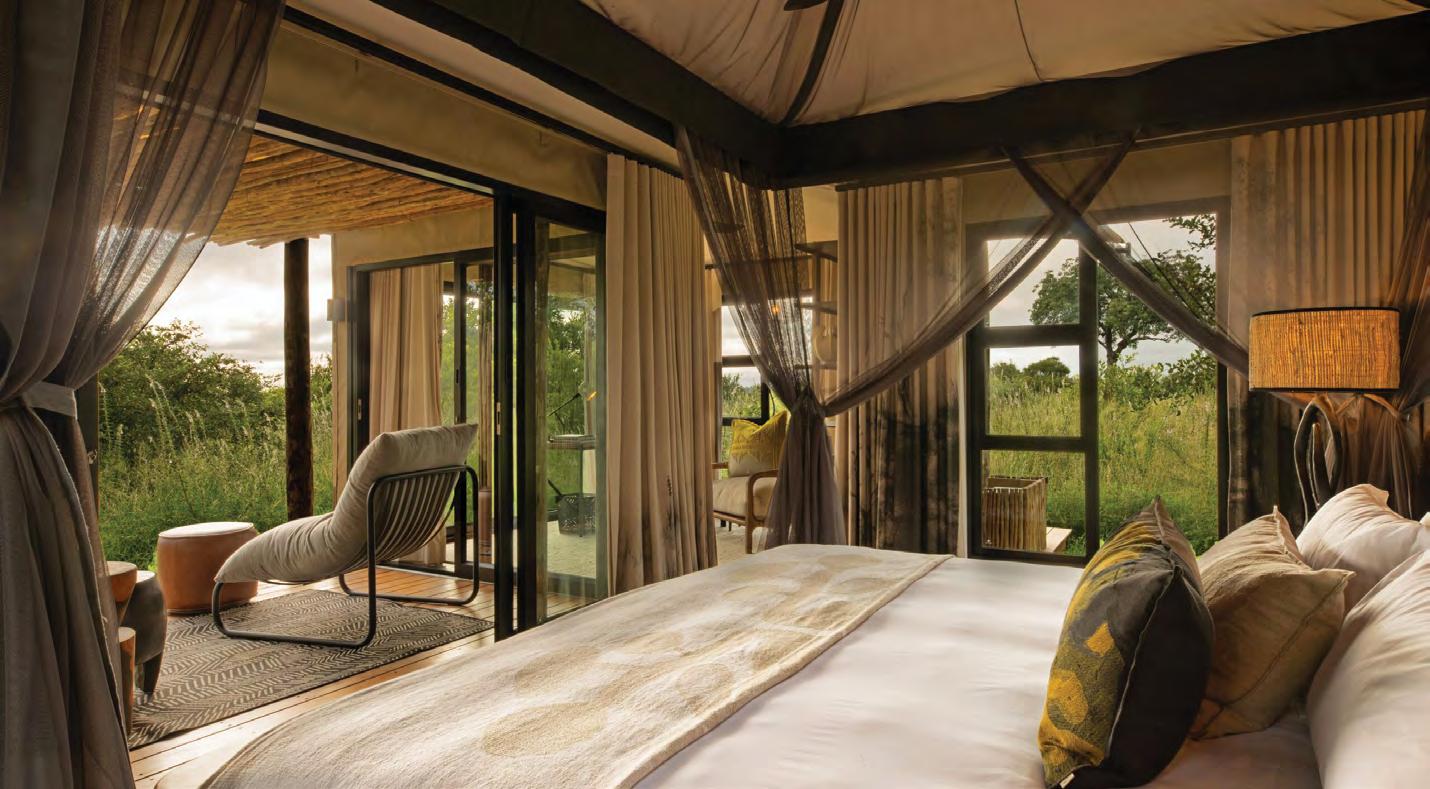

LIRI Sleep Beneath the Stars
Adhering to the design concept of “natural symbiosis”, the Liri MORE TENT Glass Dome House uses tempered glass to form a sleek, streamlined spherical structure that delivers an immersive outdoor living experience.
With its 360° panoramic view and a flexible diameter ranging from 5 to 15 metres, the dome can be adapted to any setting — from mountain peaks and lakesides to forests, grasslands and deserts. During the day it gleams like a crystal ball within the landscape, and by night it becomes a private stargazing sanctuary where guests can drift to sleep under the stars.
The column-free design maximises visibility and allows interior spaces to be freely arranged into comfortable rest areas, viewing lounges, or ensuite bathrooms. Paired with an intelligent dimming system and privacy sunshades, guests can effortlessly switch between a fully transparent “open view” and a secluded retreat at the touch of a button.
Constructed with a three-layer composite curtain wall system, the Glass Dome House ensures
durability and comfort in all climates. The inner layer of carbon crystal panels, a middle layer of 40mm polyurethane insulation, and an outer layer of double-glazed tempered glass combine to offer thermal efficiency, UV protection, and sound insulation. The result is a stable indoor temperature and a quiet, relaxing atmosphere — even in harsh environments.
The robust aluminium alloy frame withstands winds above level 10, while the dome’s modular design allows for rapid assembly and disassembly, making it ideal for resorts, glamping camps,
eco-retreats, or private villas. Optional upgrades include integrated air-conditioning, underfloor heating, solar panels, and ambient LED lighting to create an atmosphere that is as luxurious as it is sustainable.
With years of experience in cultural tourism architecture, Liri provides full-service support for global shipping, installation, and project design. The Glass Dome House offers glamping operators a striking, low-impact solution that blends luxury with nature — turning each site into a destination where guests can truly sleep beneath the stars.


